Results 121 to 150 of 313
Thread: Paradox AAR - Saga of the Slavs
-
2019-09-04, 11:20 AM (ISO 8601)Ogre in the Playground

- Join Date
- Feb 2016
- Location
- Earth and/or not-Earth
- Gender

 Re: Paradox AAR - Saga of the Slavs
Re: Paradox AAR - Saga of the Slavs
Based on recent history, I think it would make the most sense for Poland to concentrate its territorial expansion in the colonies - perhaps try to force out every other colonial power in the regions you've expanded into. Alternatively, you could try to put an end to the rise in conflict between Moscow Pact states, either by siding with the defender in any inter-Pact war or by vassalizing them all. After all, Poland is the defender of Slavdom, and sometimes that means defending Slavs from each other.
Last edited by InvisibleBison; 2019-09-04 at 11:21 AM.
-
2019-09-04, 11:35 AM (ISO 8601)Ogre in the Playground


- Join Date
- Jun 2005
- Location
- Zagreb
 Re: Paradox AAR - Saga of the Slavs
Re: Paradox AAR - Saga of the Slavs
There are a group of Slavs not protected by the Moscow pact, the South Slavs. The time has come to free them from their allegiance to the pope and other catholic states (and get good vacation spots on the Adriatic).
-
2019-09-07, 01:02 PM (ISO 8601)Ogre in the Playground


- Join Date
- May 2009
 Re: Paradox AAR - Saga of the Slavs
Re: Paradox AAR - Saga of the Slavs
I'm inclined to recommend taking over Indonesia, though I don't know how much benefit Poland would gain with the way trade nodes are set up. Maybe go for some
unrestrained colonialismglorious imperial conquest in Japan/China later on?ithilanor on Steam.
-
2019-09-23, 02:24 AM (ISO 8601)Bugbear in the Playground


- Join Date
- Jun 2010
- Location
- Helsinki, Finland
- Gender

 Re: Paradox AAR - Saga of the Slavs
Re: Paradox AAR - Saga of the Slavs
Just popping in to say that I haven't abandoned this: my summer vacation just ended, leaving me with less free time, a lot of which is taken up by other hobbies and obligations. I'm still trying to get updates out every now and then, hopefully sometime this week, but some level of slowdown will definitely persist for the time being.
-
2019-11-15, 07:03 PM (ISO 8601)Ogre in the Playground


- Join Date
- May 2009
 Re: Paradox AAR - Saga of the Slavs
Re: Paradox AAR - Saga of the Slavs
Any news on this? Curious how our favorite alt-history wacky Poles are doing.
ithilanor on Steam.
-
2019-11-22, 06:37 AM (ISO 8601)Bugbear in the Playground


- Join Date
- Jun 2010
- Location
- Helsinki, Finland
- Gender

 Re: Paradox AAR - Saga of the Slavs
Re: Paradox AAR - Saga of the Slavs
I'm afraid it's definitely slipped into another unplanned hiatus due to me being distracted first by schoolwork and then, full disclosure, stuff such as other games too. I tend to get kinda monomaniacal when I do start updating again, but that just means it's even more time-consuming. I'm not burned out or bored with the game itself, though, so an update will definitely come when I find the time and energy.

-
2019-11-22, 11:42 AM (ISO 8601)Barbarian in the Playground

- Join Date
- Dec 2009
- Location
- Massachusetts
- Gender

-
2019-11-23, 12:39 AM (ISO 8601)Ogre in the Playground


- Join Date
- May 2009
 Re: Paradox AAR - Saga of the Slavs
ithilanor on Steam.
Re: Paradox AAR - Saga of the Slavs
ithilanor on Steam.
-
2020-01-07, 03:22 PM (ISO 8601)Bugbear in the Playground


- Join Date
- Jun 2010
- Location
- Helsinki, Finland
- Gender

 Re: Paradox AAR - Saga of the Slavs
Re: Paradox AAR - Saga of the Slavs
Chapter #40: Going South (Stanislaw II, 1685-1695)
Spoiler: Chapter9 May, 1685
Despite being something of an emergency replacement after the accidental death of the previous heir, Stanislaw II ended up having a full twelve years to learn the craft and grow up into a fine monarch. Like many Poles these days, he’s quite globally and economically minded, already bursting with ambition to continue Polish expansion in areas where he feels it’s been lagging.
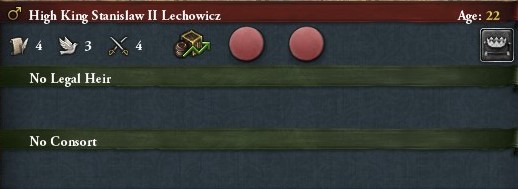

The heart of Poland’s colonial empire is of course in Amatica, where the three voivodeships of Buyania, Lukomoria and Jeziora combined far overshadow mainland Poland in terms of area, though obviously not population or wealth, and almost resemble nations of their own with unique melting pot cultures. The south of the continent is dominated by the Asturians (and their conquered Andalusians, who have fled to the colonies en masse, but also have their own stronghold in the far west Kalifania), and there are places where the border could bear to be adjusted a bit; however, there’s plenty of “unclaimed”, a.k.a. native land to give both sides plenty of space without having to go to war directly. This region is in fact not Stanislaw II’s top priority.

His eyes aren’t on Africa either, which the Poles largely treat as an oversized rest stop, but the East Indies. The last farce of a war against the Sultanate of Brunei showed that the local states aren’t to be underestimated, but also their potential value if added to the colonial empire. Poland is by far the dominant European power in the east, but Italy and Asturias have also acquired bothersome, if still small, outposts of their own, and could quickly gobble up Poland’s potential targets if left unchecked.
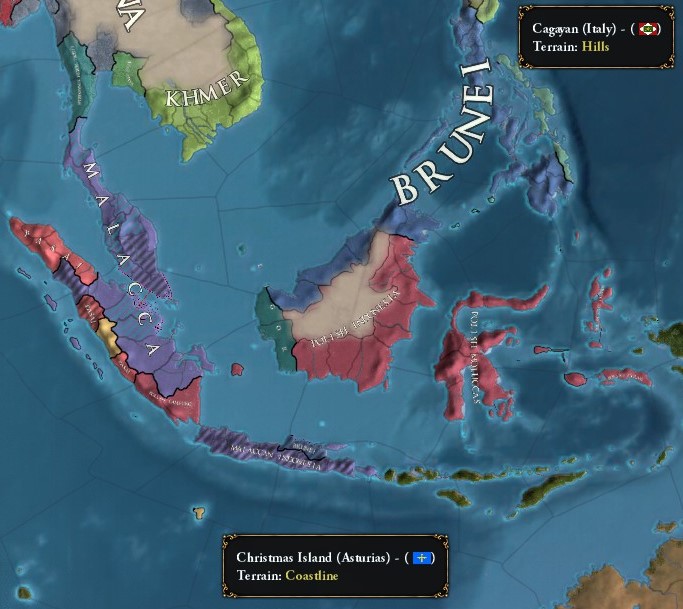
The East Indies are also important as the pathway to Stanislaw II’s other passion project: the new continent to the southeast. He’s been following the settlers’ progress intently since they first made landfall a few years ago, and though the coastline has been quite thoroughly mapped, the sheer scale of the inland wilderness boggles the mind. Who knows what sorts of treasures it might hide – the settlers have already found plenty of mineral riches, if not necessarily a literal city of silver like in Alcadra. However, even as the Poles have clearly claimed the continent itself (and tentatively named it Nowa Straya), the Italians have set up a pesky little base here as well.
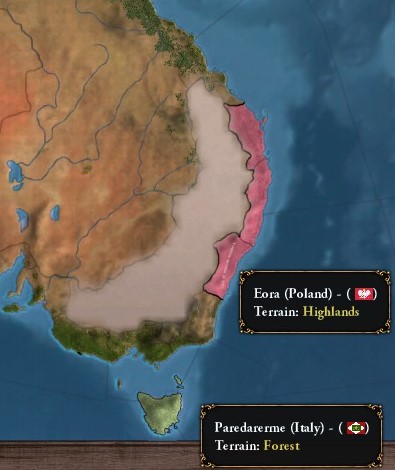
As Poland gears up for a new wave of conquests, though, Stanislaw II first focuses on laying the groundwork at home. This massive expansion of Poland’s military manufactories is targeted not just at its European provinces, but the colonies as well, as being able to produce supplies at the front obviously makes logistics a lot easier.

And so, as Poland’s understanding of the world, its shape and its political realities grows ever deeper, it becomes easier and easier to – intentionally or not – start thinking of countries and continents, people and nations, simply in terms of precisely calculated numbers and resources to obtain and exploit…
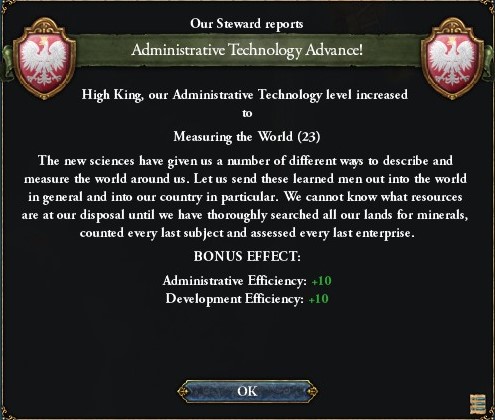

It would be silly to claim that the ‘justness’ or ‘righteousness’ of their wars has ever been a conqueror’s first priority, but it’s never been mere empty talk either: what is considered a fair reason for war by the people waging it, never mind everyone watching, changes on time and place and always somehow reflects their values, even if in the end it is mere rhetoric. For most of Polish as well as Christian history, religious rhetoric has been the most popular of all, but in the wake of Europe’s increasingly confusing political situation and the writings of certain Renaissance writers, a certain philosophy is putting into words what many people have believed since time immemorial:
Might makes right. Success proves justification. The fact that you’re able to invade and conquer someone shows that you have the right to do so. Not that the people being invaded usually agree.
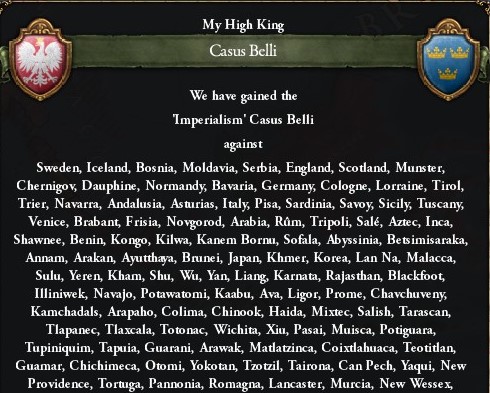
This philosophy certainly appeals to High King Stanislaw II, one of its loudest advocates even above the other Poles. The first such recipient of Polish mercy shall be the Sultanate of Malacca, the other major power in the East Indies besides Brunei. Presently under attack by Ligor and all kinds of rebels, it’s clearly unfit to take care of itself or its citizens.


That war shouldn't be much trouble, becoming a de facto proving ground for newly developed armaments and tactics as well.

Since it’s neither necessary nor even possible for Stanislaw II to personally direct that war, though, his attention is pulled elsewhere. Besides the overall burst in imperialist thinking, there’s been a recent uptick in Polish interest in their southern neighbors – the South Slavs, or Carpathians as they’re sometimes called, not deserving of the name Slav. Stuck on the wrong side of said mountains, they were conquered and converted by monotheists long before the Slavic Church could even be founded, thus basically separating them from the wider Slavic community forever. However, while culturally Slavic in some ways and vastly divergent in others, their awkward position has often made them distrusted on both sides of the religious divide and the South Slavic region a strange borderland, seldom as important as either Germany to the west or Moldavia to the east.
The main South Slavic power at the moment is the Princedom of Pannonia, part of the Francian Empire but Lollard in faith, which has recently been on a conquering streak against its weaker neighbors. However, practical and “cultural” interests alike have started to demand that the South Slavs be at long last liberated and reunited with their brethren. It’ll take a lot of adjusting for them, of course, but they’ll see that they’re better off in the long run. Poland, meanwhile, wouldn’t mind having a stronger presence and maybe even some ports in the region, often critical in its wars against the Franks. It could also be seen as a symptom of Poland’s loss of hegemony over its fellow Slavs and former vassals: just go acquire some new ones.

Polish envoys politely inform their Scottish allies that being too close with the Pannonians might not be a very good idea these days. After all, Poland is the one who came to the Scots’ aid when the German-Pannonian war in 1663-67 threatened to ruin them entirely. They seem to take the hint.

War is declared in August 1687. First will be the Pannonians. Then the Croats, Bosnians and Serbs.
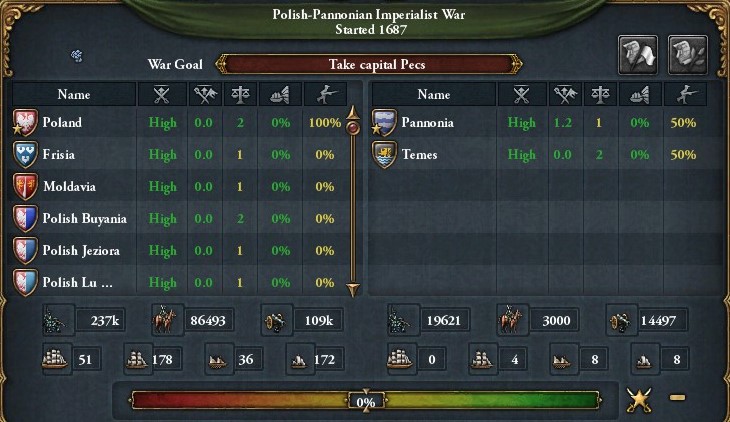
The Emperor in Navarra is too weak, too bankrupt and on too bad terms with Pannonia anyway to interfere in the war. It thus looks like another unresisted cakewalk.
However, if the Poles think they’re conquering lots of territory just by rolling down into Pannonia, the Swedes have them beat by far. After a long and painstaking war, made difficult by the sheer amount of far-flung territory being fought over, King Alf II of Sweden forces a momentous peace treaty on the ever-dwindling Andalusians that includes the transfer of nearly all of Andalusia’s Alcadran colonies, including the strategic isthmus in the north and the vast Narafidian provinces in the south. Andalusia was the very first to discover and settle that continent, but now it only holds on to a few scraps, while the vikings of all people control the largest piece of it by far.


In any case, the Pannonians retreat south and hide for as long as they can, but when it becomes clear that this is achieving nothing, they make a glorious last stand against the Polish troops under Trojden Zaluski (grandson of the Trojden ‘Madman of Mazovia’ Zaluski who got himself famous in the Confederate Civil War). With their backs well and truly broken, they scamper off once more and leave the Poles to their bloody work of ‘liberation’. Although, having clearly already won, the Poles try to be a bit more light-handed from here on.

Germany seems to be in the mood for some Slavic consolidation as well, seeing as how King Leszek II Lechowicz declares himself the prospective heir of his cousin, King Andrei IV of Novgorod. His claim is indeed legitimate (not counting the terms of Moscow Pact), but Andrei is still young and simply hasn’t had time to have children of his own yet; however, should something happen to him, this could create either a nearly Pan-Slavic union with Germany, Vladimir and Novgorod all under one crown – or start another great Pan-Slavic war.

The invasion of Malacca is brought to an undignified end in June 1688 as the East India Company annexes most of Java, the southern tip of Malaya and various outlying islands; it’s the most they feel comfortable taking without overextending themselves or clashing with the other local rulers for now, but will serve as a springboard for future conquests. Poland is now the clear master of the lucrative spice trade, and overlord of an increasing number of Muslims and Hindus.

Some months later in November 1688 comes the far more dramatic Treaty of Kaposvar, which brings the annexation of all of Pannonia’s Slavic-majority provinces, as well as the cities of Laibach and Wien because of their important location (and great value). One Hungarian province is handed over to Moldavia. However, besides Wien which is combined with the previously conquered Ostmarch, Stanislaw II doesn’t consider it either practical or necessary for Poland to govern all the South Slavic lands directly.

Instead, his plan was always to create another autonomous state that would take care of its own business while securing Poland’s interests in the area. He likes to compare it to Frisia, which has been a relative success story so far, but the ancient (and horribly failed) Congregation of Germany might actually be a better comparison: an artificial pagan state imposed from above on conquered Christians, with only the thinnest veneer of legitimacy. To undermine the local elites, he doesn’t place the court in the Pannonian capital of Pecs, but rather the nearby Kaposvar where the treaty was signed. In hopes of making it a cultural union of all the South Slavs, this state is named the Principality of Yugoslavia... 'Land of Southern Slavs'. Unlike a voivodeship, it'll be a hereditary position held by a Lechowicz line, but not on the level of a Grand Duchy due to the Sejm protesting against it.
Stanislaw II has no illusions about how his Christian cousins are going to receive their new pagan overlords, especially in the short term; however, even if the most ambitious dreams of Slavic unity prove impossible to ever achieve, at least Poland can reap the practical benefits. He plans to continue farther south as soon as the Yugoslavian state has been stabilized.
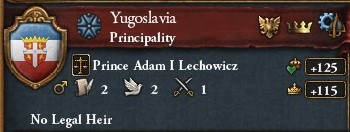

There's no immediate reaction of terror or disgust from the rest of Europe, beyond that which they feel towards the Poles to begin with. Soon after, Lorraine finalizes the annexation of the last scraps of Lotharingia, removing the last independent Karling rulers from the map – though obviously some members still remain wealthy and influential within other countries. It's a good reminder of just how cutthroat European politics truly are, with or without some shallow excuse.

Germany is also perfectly happy to pounce on Pannonia and try to grab what’s left of it. This isn’t really a problem from Poland’s point of view, since the Austrian provinces in question are largely German-speaking anyway and thus don’t really fit into the Yugoslavian dream.

The conquests of Malacca and Pannonia were both pleasantly easy and low on casualties, too, leaving Poland in what should be great shape for more conflict wherever it can find it. As it turns out, that ‘wherever’ might be a bit away from its own borders again, for in April 1690, its close if somewhat cordial ally the Kingdom of Chernigov requests help in its war against the Muslims down south.
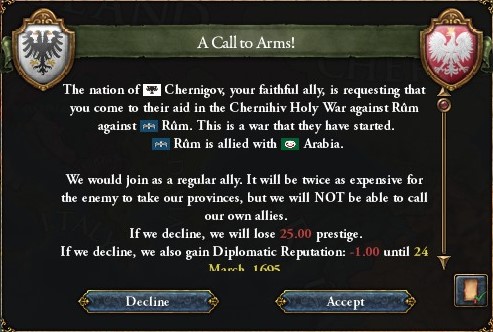
The Poles still have no special grievance with the Muslims, but have gotten used to fighting them by now due to their proximity to Moldavia and tendency to get tied up in European politics. Naval dominance has made them quite easy to deal with on the defense, but having to take the fight to them – into vast, unknown and infamously difficult territory – might be a different story. Still, with its friends among the Slavs dwindling, Poland can’t afford to lose the allegiance of Chernigov, so war it is.
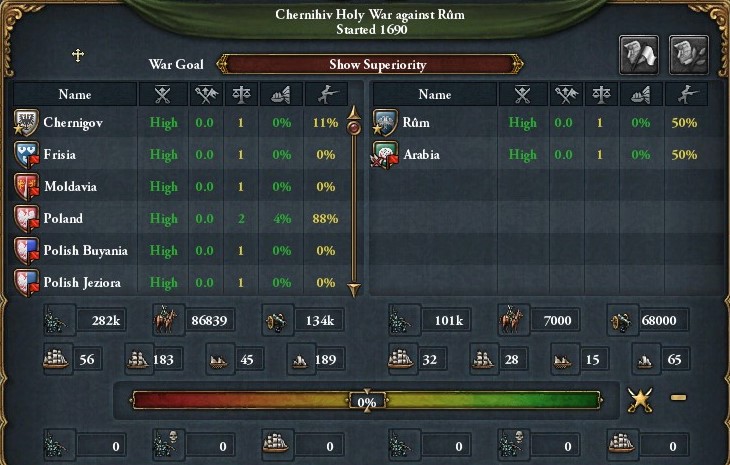
The autonomous Moldavian army and Yugoslavia’s hastily cobbled together militia are given orders (or rather permission) to stay back and protect their own territory from enemy raids, letting Poland focus on the offense. The Black Fleet moves to block the Sea of Marmara as usual, while the armies begin their long trek south. At first, the High King is expecting to stay home and take care of politics like he did until now, but there’s actually a surprising amount of grumbling about him starting all these big wars yet not taking responsibility by leading his armies in the field like a true Pole should. Without any further ado, he puts on his armor, straps on the Axe of Plusdwa and joins the convoy. He likes to think he’s not a half bad commander himself.

One would hope that the Polish bureaucracy could handle routine matters in his absence, but that doesn’t seem to be the case, and it seems like his “reckless” foreign policy has its detractors as well, causing trouble with setting up the Yugoslavian puppet state and getting people to accept or at least acknowledge its existence. There’s also been major uprising in Wien which part of the army must stay back to suppress.


(What’s with the typos in these specific events?)
The war itself gets off to another good start, with the Poles rolling in pastConstantinopleLechogród and into undefended Rûman territory, the enemy army being busy fighting Chernigov farther east. On their way in, though, they get a good look at just how effectively the Rûmans have Arabicized the former Byzantine Empire, using conversion work and resettlement to make their religion dominant throughout Anatolia and changing the place names as well: Smyrna to Samirana, Ancyra to Anqara, Archelais to Aksari and so on. Not that Poles don’t do the same, of course. Greek also remains the majority language of the people for now, though Arabic is used in the administration.

After a bit of probing and no clear counter-attack, Stanislaw II decides to make use of the opening and drive his army towards Adana, the Third Rome itself. On the way there, though, he in fact manages to find the Rûman army – or vice versa – and ends up caught in a battle that he, for all his supposed tactical acumen, cannot win. He manages to cause some respectable casualties to an army twice his size, but is driven back nonetheless.
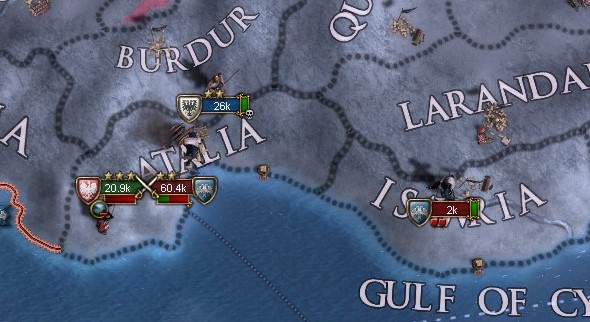

The Chernihiv back-up on its way to bail him out manages to get caught in the exact same trap he did, only to be rescued just in time by another wave of Polish back-up. The Slavs emerge humbled and more cautious, but victorious nonetheless.
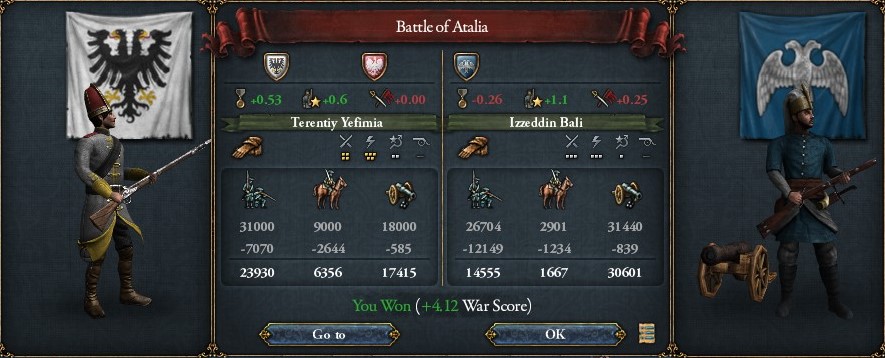
Still, because of this whole mess, the Chernihiv end up beating him to Adana. No matter, as long as someone takes it. When the city is captured and the Rûman navy driven out of port, the Black Fleet gets perhaps its first real chance to shine as the Arabian navy rushes in to help and one of the largest sea battles in Mediterranean history begins in the Gulf of Cyprus, New Year’s Day 1692. The Rûman navy is impressive, but the Black Fleet earns great glory by managing to send its imposing flagship to the bottom of the gulf.
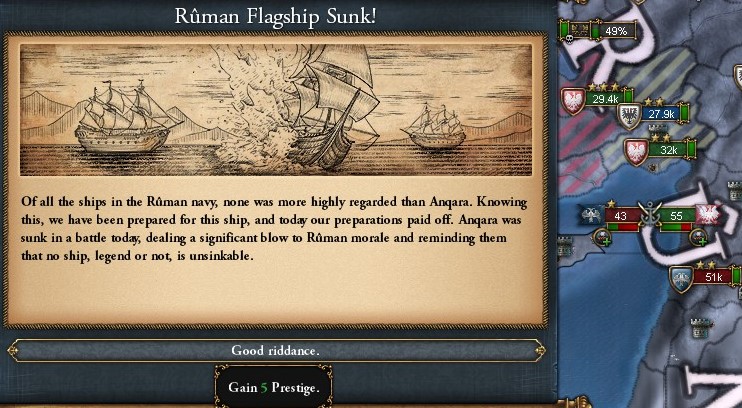
Frankly, looking at the numbers, it’s nothing short of a miracle that the Poles’ victory is as overwhelming as it is. There will be much feasting and toasts to Kupala tonight. The Black Fleet decides to take a break while it’s ahead, though, and return to Crimea for replacements and repairs. Much of it is barely keeping afloat.

Through several more battles, the Muslims are forced to retreat south and leave the Slavs to conquer their way across Anatolia, but it’s slow going with the heavy fortifications and mountainous terrain. When their supplies start to run low, or even just because, especially the less disciplined parts of the Slavic armies often take what they want from local towns and villages with or without permission from above. Stanislaw II doesn’t see much point in stopping them, though. Lets him save money on salaries.

One army, however, wanders off into the Armenian mountains and is never seen again. Rumors spread that they’ve been caught in a massive ambush and wiped out to the last man, even the few survivors chased down and tortured to death by the vengeful enemy. Rûman general Dervis Gümülcineli, effective but obviously highly brutal, is later painted in Polish folklore as a literal mountain demon who supposedly left the whole region littered with mutilated soldiers.

When the High King hears of what happened, the Poles immediately drop everything else and convene on the area to avenge their 32,000 dead brethren. After the initial victory, what follows is a long series of battles over the spring of 1693, in which the surviving Rûmans keep desperately skirmishing and running around the mountains trying to escape. However, they’re surrounded by occupied territory and it’s only a matter of time until they and their commanders meet the same gruesome fate as the Poles supposedly did. Gümülcineli, demon that he is, still manages to slip away by transforming into smoke.
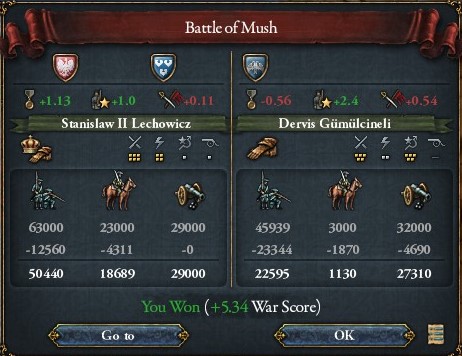
Though their honor’s been restored, this war has turned out surprisingly expensive after all and also stoked a whole new kind of anti-Muslim sentiment where they used to be the one neighboring religion the Poles didn’t mind too much. Never mind that the Slavs are actually the attackers in this whole war. Although, despite that righteous fury, this whole incident seems to have sharply reduced their enthusiasm for the war, and they end up taking a much more passive, occupying role while entrusting most offensive operations to Chernigov. Stanislaw II remains at the front, though, to support his troops, setting up camp in Damascus and trying his best to keep track of any news from Krakow, though all seems relatively quiet on the home front.
Even if victory is inevitable, though, this unnecessarily extends the war, so by late 1694 the High King decides to join the King of Chernigov in hastening the occupation of Egypt so the Poles can actually go home sometime.

In February 1695, the army under Stanislaw II takes Alexandria – basically Arabia’s second capital besides Mecca – and smaller detachments are sent out to establish control of the countryside. They have subzero interest in wandering any deeper into the infamously vast and barren deserts of the vast Arabian Empire, though, so Chernigov basically receives an ultimatum to get the peace deal over with.
That is finally achieved in November 1695, when Chernigov walks away with a lot of Anatolian and Armenian land watered with Polish blood, and Moldavia also receives the once great city of Smyrna/Samirana for its troubles. It doesn’t really feel proportionate to the sheer amount of work it took, though, and Stanislaw II isn’t going to have the warmest welcome waiting for him back in Krakow.
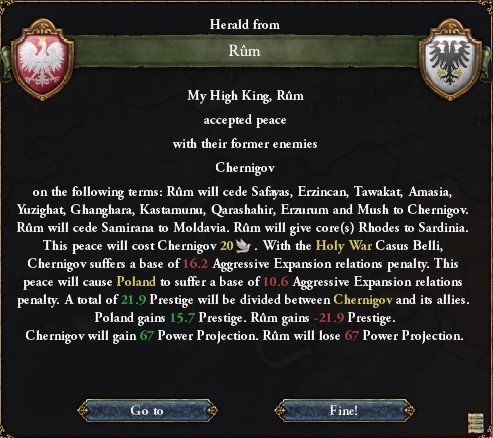
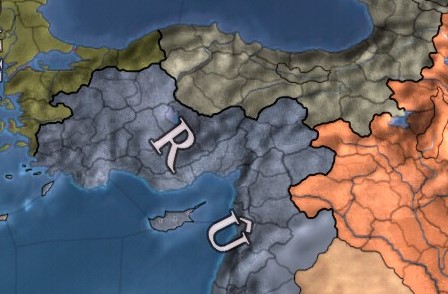
However, they might be up for a surprise as well, as five years on the unusually brutal front enforcing his unusually cold-hearted approach have brought to the surface a far less pleasant side of the formerly jovial monarch, now 32 years old and still in for a long reign, but scarred in more ways than one. It might be that when he starts streamlining Polish society to his optimized vision, the ‘human’ side of human resources may find itself increasingly backed into a corner…
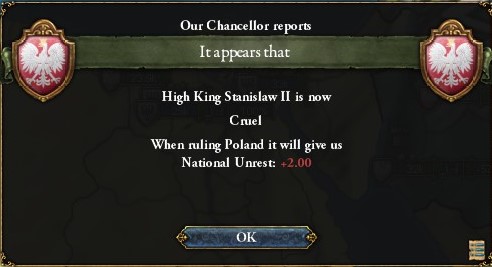
Spoiler: War & Map Highlights(I’ve decided to cut down on war “highlights” about less dramatic wars, since for some reason these are one of the most tiresome parts to write right at the end of an otherwise ready chapter)
Slavic Holy War for Anatolia (1690-1695)
Chernigov + Poland vs. Rûm + Arabia
Chernigov requested Poland’s aid in its invasion of Rûm and Arabia, the two greatest Muslim powers. Despite several tactical mishaps and lost battles, the war itself got off to a winning start with Stanislaw II himself at the head of the troops. However, the clear low point of the war was the mutual Massacres of Mush, where first a Polish army was ambushed and destroyed in the Armenian mountains and then the same was done to the Rûmans in retaliation, involving the killing of tens of thousands of captured or wounded. The following occupation took the Poles and the High King as far south as Egypt. While the treaty failed to secure all of Anatolia, which was a long shot from the start, it did secure the last bits of the Black Sea coast and greatly expand the Slavic buffer in Anatolia and Armenia.
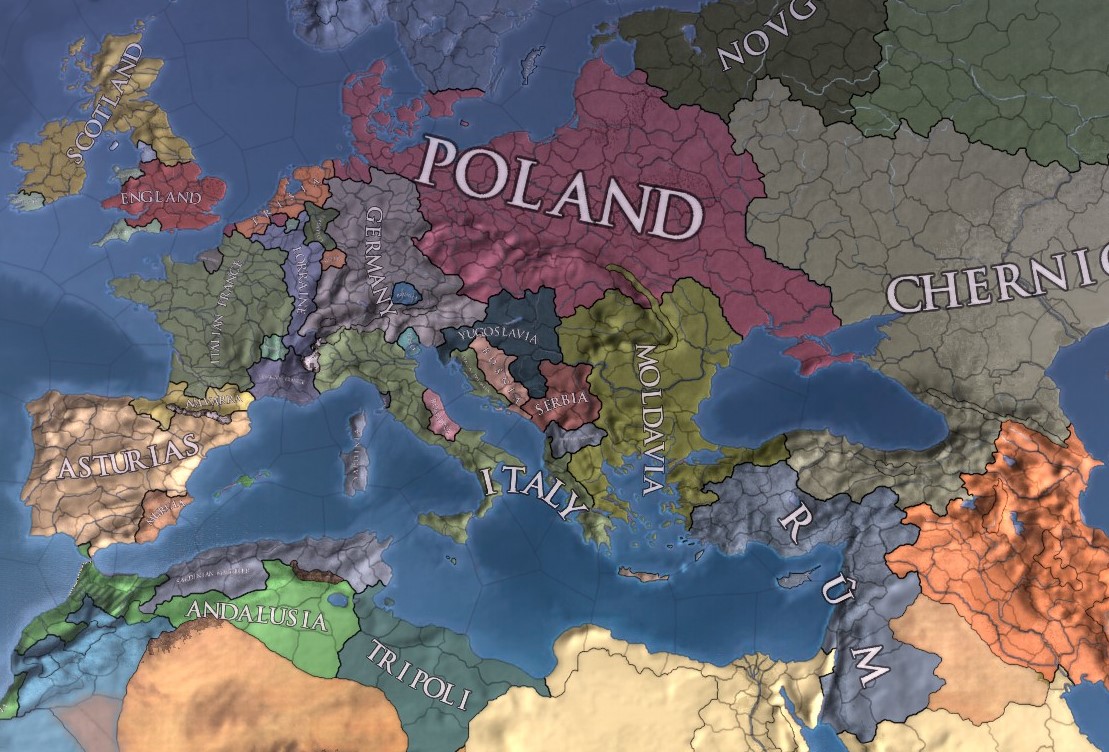
- Germany-Vladimir, which is quickly shaping up to be one of the major powers besides Poland and Italy (and on hostile terms with both), has annexed the rest of Pannonia and recently started an invasion of Lorraine. The King of Novgorod has gotten some children of his own, meaning that another succession war shouldn't be imminent but the tension remains.
- Sardinia is as ever in a constant state of flux, gaining land on some fronts while losing it on others (and currently under attack from Serbia).
- Between Asturias and Kanem Bornu, Andalusia’s days as a state are well and truly numbered, but there’s a massive number of Andalusian Muslims living across the Atlantic.
Spoiler: CommentsThe Imperialism casus belli is so weird. I don’t think there’s any historical reason in particular for it to be in there, it’s just to shake things up in the late game. “Nationalism” being unlocked in the late 1600’s is even weirder, but that’s mostly just the name, since all it does is give you a tool to unify your culture group. Which we already have.
Anyhow, back at it again! I once again decided/had to reread the entirety of the AAR just to remember exactly where I was, which took surprisingly long but also helped me get hyped up to continue. In a perfect world I’d be able to update, say, on a regular schedule of every couple weeks, but unfortunately the way time and motivation works seems to be closer to rapid bursts with longer breaks instead. Anyhow, I’m still on the 1.28.3 patch (before the Manchu Update) to avoid compatibility issues, and nothing else should’ve changed either.
I need to get my bearings again, decide where I’m gonna go from here and possibly do some additional modding related to that. I’m still dealing with university, other projects and such, though, so hopefully the schedule from here will be along the lines of “every now and then”.
Some things on the to-do list, besides reacting to the AI:
- Expand Yugoslavia down into Kosovo. Macedonia and Albania remain solidly Greek in this timeline, though ignoring that and conquering them anyway would probably be on-brand…
- Keep mopping up the East Indies. Possibly drive the other Europeans out, though on a meta level I don't mind their presence.
- Decide what we’re doing with Moldavia. The union isn’t going to break on its own, but we could plausibly just roleplay a reason to cut them apart manually (…again). Maybe this time on their own initiative. On the other hand, since we can reduce the balance impact of their military contribution by just telling them to stay on the defensive, it’s not 100% obvious whether we need to. Puppets aren’t terribly gamebreaking in Vic 2, either.
- Preferably deal with Rajasthan somehow (I’ve considered simply occupying them and letting separatist rebels do the rest), but even though I’d likely win numerically speaking, a continent-wide invasion front feels both unrealistic and like a nightmare to play. It’s not gonna get any better in Vic 2, though…
Input is appreciated! And as usual, feel free to ask for status updates on any part of the world and all that.Last edited by SilverLeaf167; 2020-01-08 at 04:34 AM.
-
2020-01-07, 04:10 PM (ISO 8601)Ogre in the Playground

- Join Date
- Feb 2016
- Location
- Earth and/or not-Earth
- Gender

 Re: Paradox AAR - Saga of the Slavs
Re: Paradox AAR - Saga of the Slavs
I'm glad to see this excellent AAR resume.
Why do you feel a need to do something about Rajasthan? Looking over the past few updates, they don't seem like much of a threat to Poland.
-
2020-01-07, 04:56 PM (ISO 8601)Bugbear in the Playground


- Join Date
- Jun 2010
- Location
- Helsinki, Finland
- Gender

 Re: Paradox AAR - Saga of the Slavs
Re: Paradox AAR - Saga of the Slavs
Oh, just on a meta level, really. The continent-sized orange blob annoys me as a matter of principle.
 Though partly for that same reason, you're right that it's hard to justify putting the effort into invading them.
Though partly for that same reason, you're right that it's hard to justify putting the effort into invading them.
Though if anything, it is kinda amazing how irrelevant (and seemingly weak) they manage to be despite their size.
-
2020-01-08, 10:06 PM (ISO 8601)Ogre in the Playground


- Join Date
- May 2009
 Re: Paradox AAR - Saga of the Slavs
Re: Paradox AAR - Saga of the Slavs
Haven't read the update yet - I'm going to reread a bit to remember what's going on - but it's great to see this come back!
EDIT: Caught up. A few comments:
- I didn't realize how far inland the Polish Amatican colonies went; that's impressive.
- "Nowa Straya" made me chuckle.
- I'm almost sad to see that a succession war over Novgorod isn't a possibility; that would've been fun to see.
- Interested to see what becomes of all the Andalusian pops in Vic 2.
- Rajasthan feels like it'll have major rebel troubles in Vic 2, though I don't know what its demographics are like. Maybe just let it fall apart then, sort of analogous to the Ottomans in our timeline?
Last edited by IthilanorStPete; 2020-01-09 at 08:34 PM.
ithilanor on Steam.
-
2020-01-17, 09:21 AM (ISO 8601)Bugbear in the Playground


- Join Date
- Jun 2010
- Location
- Helsinki, Finland
- Gender

 Re: Paradox AAR - Saga of the Slavs
Re: Paradox AAR - Saga of the Slavs
Chapter #41: Age of Empires (Stanislaw II, 1695-1711)
Spoiler: Chapter24 November, 1695
Stanislaw II might still have a long reign ahead of him, and not necessarily one his subjects are going to enjoy. At the time he took the throne, his promises of expansion in the East Indies and especially Yugoslavia were met with roaring popularity – and success – but the aftermath of the latter has turned out to be more complex than expected, not to even mention the long, bloody and expensive war against Rûm that may have also been a victory but seemed to bring Poland little direct benefit (Moldavia, which gained Smyrna, is treated as the separate country it practically is. Chernigov, though currently an ally, is seen as a potential enemy at the drop of a hat). Not to even mention that he’s returned from said holy war more than a bit changed himself.
He isn’t a particularly proud man, so he isn’t so much disappointed or angered by the lukewarm reception he gets on his return to Krakow just in time for the winter solstice festivities as he is concerned. If people’s faith in him or his decisions falters at the first hint of gritty reality, well, he has his work cut out for him.
In the far, far east, about as far as you can go before ending up west, a different imperial power stirs: the Japanese Empire, in effect led by a military dictator known as the Shogun, has stayed in relative isolation for the past 160 years after first securing some ports and tributaries on the mainland, only to now finally awaken to the same forces of conquest for its own sake that the likes of Rajasthan and the Europeans have been kindly exporting to the rest of the world. Having rejected most European approaches but allowed a small number of Italians to trade in a few select ports, Japan has cherrypicked the best part of their world-view and decided to strike south to get its own slice of the colonies (albeit on an island where the Sulu themselves are also colonists). Another potential rival in the region?
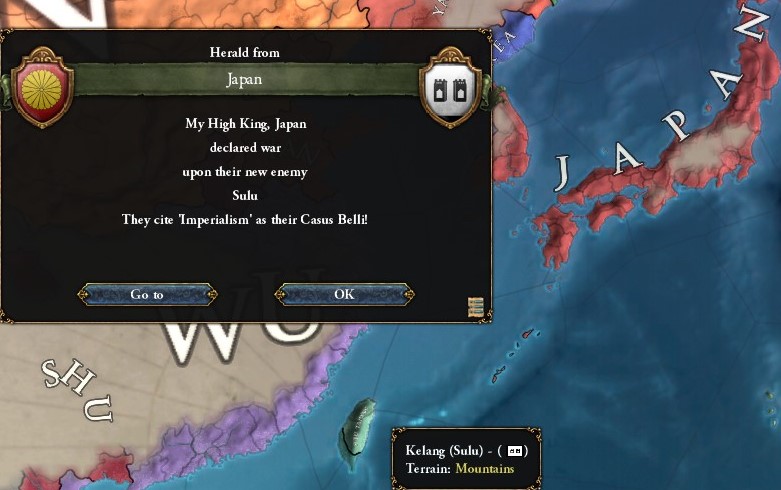
Soon after, news arrive that those Italian traders have managed to strongarm one of the perpetually weak Chinese states into providing them with an exclusive treaty port. Seems like European colonialism is reaching all new theaters.
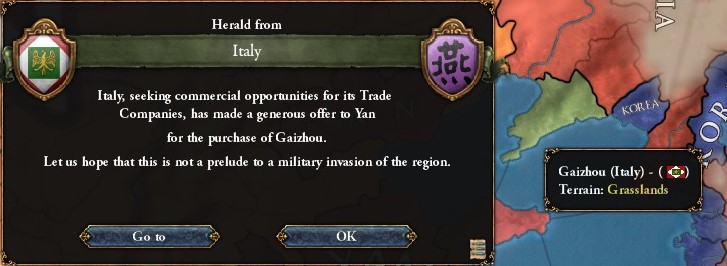
The Poles themselves are making good progress in Nowa Straya, where the local administration has requested and gained permission to form the first colonial Voivodeship outside Amatica. Based in the main port city of Eoragród (Sydney), the settlers have been happy to find that even if the outback wasteland seems to stretch on forever, the coast is nice, green and fertile and the hills chock full of precious metals. And it does mean some sort of victory over the Italians.
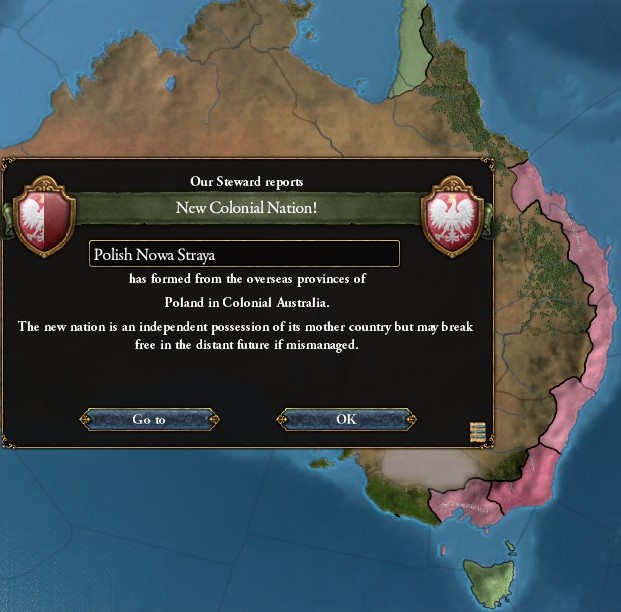
None of that translates into a real victory for Stanislaw II’s own policies, though, and he’s also not endearing himself to the nobles as he intervenes in matters that most rulers would either accept or at least overlook. Under his reign, all nobles’ foreign contacts will be strictly monitored and must go through official channels, even when they’re with nominally friendly or at least cordial nations. With three attempted coups funded by fellow Slavs against his predecessor Kazimierz II alone, he feels he has every reason to be paranoid of subjects and neighbors alike. He doesn’t hesitate to have them detained and punish them as harshly as he can without inciting a full-blown rebellion of his own.
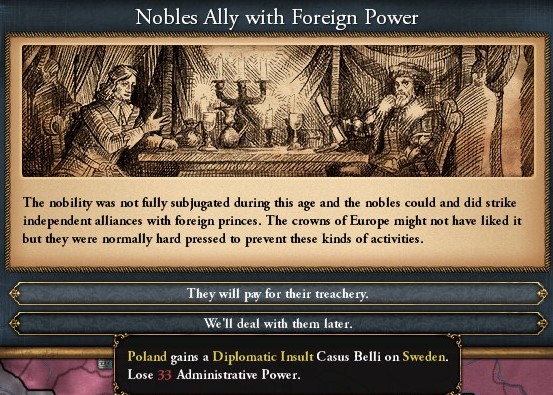
Then again, he’s careful to try and maintain what friends he does have, and can’t allow any badmouthing of his wife Malfrida Artamonovich, cousin of the King of Chernigov. Sejmic deputies railing against her and her supposedly oversized role in the administration put not only the High King’s inner circle but also the alliance at risk.

The issue of Yugoslavia’s ragtag government is one that he believes is best solved by doubling down on it and expanding the client state to its intended borders rather than the husk it presently is. Thus, in February 1697, he decides to give his grumbling subjects something else to think about by invading Bosnia, the small South Slavic state part of the Francian Empire. As such, Navarra and its allies make the vain (and nominal) decision to try and protect it, but it should once again be a matter of just marching in and taking it.
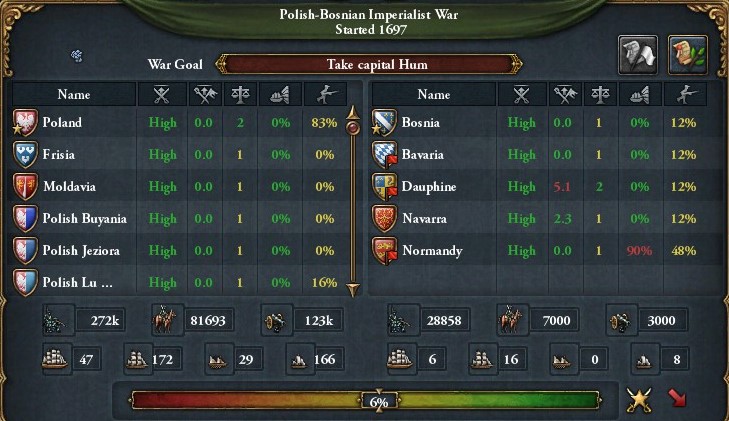
Of course, he himself still needs to show his best side by leading the attack on the Bosnian capital, the rather humble town of Mostar.

As some empires expand, others are split apart: in this case the Inca Empire, the largest Native Alcadran state to quite successfully resist more than two centuries of European colonialism. Problem is, they chose to do so by stubbornly resisting anything that even distantly whiffed of European, including firearms and other purely practical inventions, which made them quite easy for Sweden and Asturias to brazenly slice up in the space of just a few years.

Meanwhile, even though Bosnia itself is quickly occupied, the Francians decide to pull the old stalling trick and refuse to sign an official peace before the High King personally puts a gun against the Emperor’s head (usually but not always figuratively). Though the Poles could just wait it out, Stanislaw II decides to take the bait and remind the enemy of their foolishness by indeed looting and occupying all their lands as well. This takes the Poles into their first direct confrontation with the Italians in a while: even though Italy itself isn’t in the war, it has allowed Navarra to hire one of its armies in true condottiero fashion. While Italian troops are certainly among the best Francia has to offer, the army is too small and tactically disadvantaged to pose a real threat to the Poles.
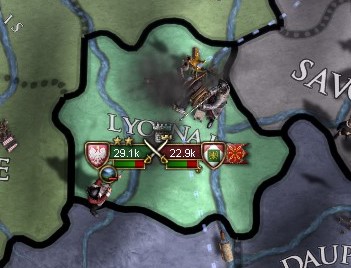
In late 1699, after a quick siege of Pamplona – a grand tradition that has frankly gone neglected for too long – it’s finally time to make a real effort towards ending this charade and truly assert long-lasting dominance over Europe. It’s a highly unusual demand, but as the Poles do in fact storm the Emperor’s residence and capture him alive, against all conventions of war and diplomacy the High King declares that he or his lands won’t be released until he makes a binding agreement (enforced by threats of Polish invasion, of course) to roll back several reforms of Francian government, most notably the Imperial Senate, which many would argue was just starting to recover from the chaos of the Heretics’ War over a century ago. Thing is, Poland would much prefer an internally divided, uncommunicative Francia, and now the Christians are indeed forced to return to the days of one-on-one diplomacy and ad hoc meetings. Well, on paper, anyway: in practice, Stanislaw II is certain that the Francians can get around the restrictions if they really want to, but this sort of upheaval is simply another slap in the face to add insult to injury and show how weak their elected leaders truly are. That should make them think twice before meddling in Polish wars again. The old man actually passes away some months later, only for the Electors to select his also elderly daughter as Empress, just as he’d hoped when he got the Senate to accept the possibility of one. Despite it being clear that there’s only one or two rulers possibly capable of handling the imperial appointment, they just keep on picking Navarra.

But now, Bosnia. It’s quite simply annexed whole and made just another administrative division in the Yugoslavian federation. The generals don’t even need to be told that Serbia is next.

As the 18th century comes to an end and the next one begins (in the Christian calendar, anyway), it’s becoming clearer and clearer that Stanislaw II’s “analytical” way of thought isn’t just an individual quirk, but part of a worldwide trend towards what could be generously described as “rationalism”. Though not inherently cold and uncaring, this philosophy emphasizes careful thought, observable fact and practical benefit over such matters as tradition, religion and emotion. Building on by now well-established staples such as empiricism (no relation to imperialism), rationalist thinkers encourage rulers to gauge and actually measure the effects of their policies rather than base them on simple belief. The most fervent rationalists exclaim that they are euphoric not because of any god’s blessing, but because they are enlightened by their intelligence. Indeed, “Enlightenment” is becoming one popular name for the phenomenon at large.
One founding center of the Enlightenment is found, surprisingly enough, in Kyoto. The Shogun has been thoroughly enraptured by the concept, or at least convinced of its practical merits, and put a lot of funding into his scholars’ efforts to collect, catalogue and hopefully analyze every bit of knowledge they can get their hands on. This also means sending out envoys to foreign lands, including Polish colonies in the East Indies and Nowa Straya. The Poles there are happy to provide some seemingly harmless scientific and everyday information, making sure to highlight the fact that they’re fellow pagans (the Japanese don’t seem to understand the concept) and thus natural allies against the hostile monotheists. However, Japan itself remains closed to foreign visitors.

The Shogun’s imperial ambitions are doing less stellar, though, as his war against the Sulu has stirred the Chinese into action and prompted a Yan-Wu combined invasion of Korea and Japan’s mainland holdings. Though the home islands remain untouched for the time being, Wu is in fact a major military power and more than strong enough to hold back the Japanese navy, stopping it from reclaiming the occupied provinces. In about a year’s time, the Japanese will indeed give up most of this territory and only be allowed to maintain a small strip of Korea, a humiliating blow dealt by people they’ve just loudly declared their lesser. The war against Sulu also ends up stalling and failing due to the delay.

Stanislaw II himself does his best to keep up with these trends. A true Enlightenment state requires not only the will, but also the tools to keep track of the world, and thus the bureaucracy and economic bookkeeping always have to keep improving. Economic planning isn’t good for much if it can’t actually tell when more money is needed and then do something about it.

New feats of engineering also enable both advanced military designs and the facilities needed to construct them.
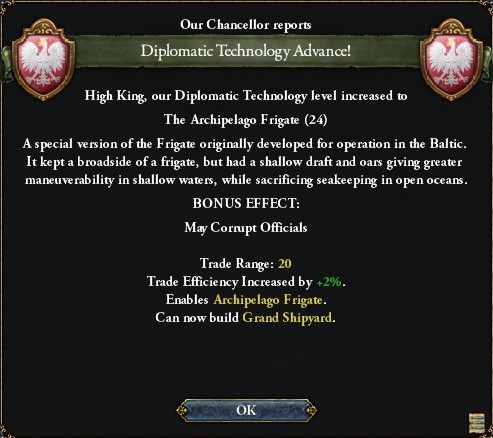
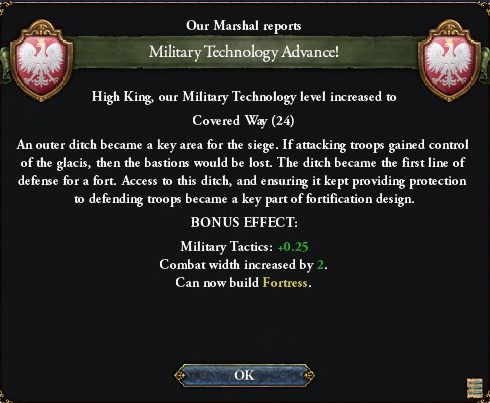
The High King is eager to start another war, but the Yugoslavian vassal government humbly requests – and rationally argues for – more time to integrate Bosnia, leading him to order the continued conquest of the East Indies instead. It seems that Poland’s expansion in the region has encouraged the local powers to seek external protection, though, forming alliances with each other, the Chinese and even faraway European powers. Christian naysayers have never posed an obstacle for Poland, of course, and the East India Company is urged to start an ambitious war that drags in Brunei, Sulu, Ligor and their so-called protector Asturias. The declaration is delivered to Burgos on Christmas Day 1701. Scotland is kind or opportunistic enough to join the Polish side.

Despite Stanislaw II’s confident demeanor and the seeming hopelessness of Asturias, though, this little colonial kerfuffle is slated to become a truly global conflict. Besides the scattered island outposts here and there, there’s plenty of border to be fought over in Amatica, and individual naval skirmishes and raids are already occurring all over the world along trade routes patrolled by both colonial empires. Whether the winner is inevitable or not, knowing the Francians, it’s going to be a long, painstaking process.
The Poles would rather keep it restricted to the colonies than wade through another guerrilla in Iberia, but that doesn’t mean the war won’t be devastating. All of Amatica does indeed become a massive battlefield as both sides’ colonial armies, eager for glory and conquest yet with little practical experience, go all in on the offensive while neglecting the defense of their own territory. When Stanislaw II hears of this, he has a rare fit of something resembling rage as he (very rationally, he’d like to add) recalls the Lukomorian Voivode, Szczesny Grzymala, to be tried for treason and criminal incompetence, ultimately leading to his beheading and replacement by the High King’s own candidate. Never before has a Voivode been dismissed by royal decree, never mind executed, and this causes a great stir within the (technically unlawful) colonial assemblies, disturbed by the fact that the High King is even able to do such a thing.

The one other Voivodeship doesn’t get off to a very good start either, as instead of focusing on the defense, Asturias manages to ship an army to Nowa Straya of all places. The small colonial militia wisely retreats into the wilderness, only to strike back after the main force has left the area, but reinforcements will be needed to take care of the threat, and the main force in the Indies already has its hands full.
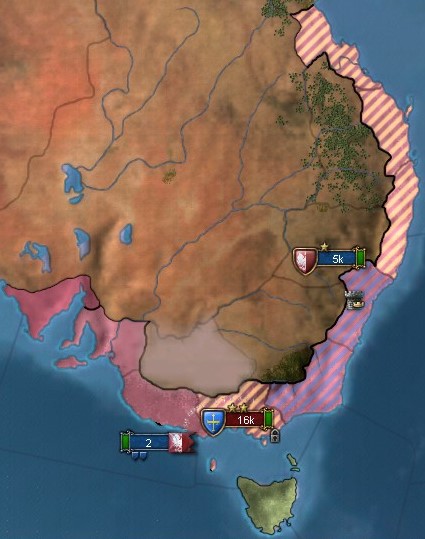
As a side note, the seemingly rising star of Lorraine is violently shot down as disastrous wars against Germany and Cologne lead to it being thoroughly dismantled. Of course, its paths for the future were already quite limited, being squeezed in between Germany and Italy.
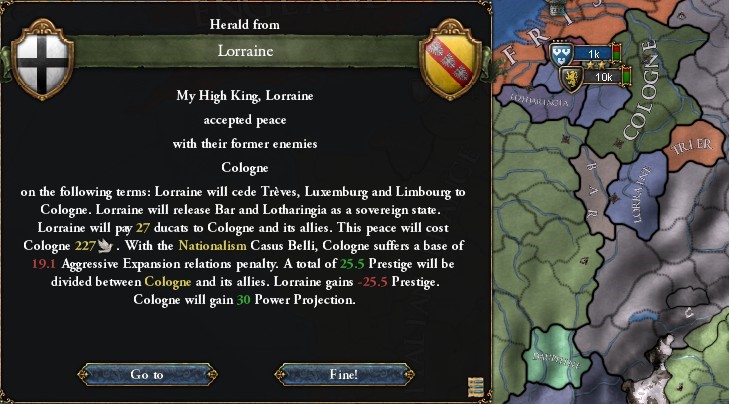
Once help finally does arrive, the Asturian army quickly finds itself stuck between an army and the merciless desert and is forced to surrender. In Amatica, on the other hand, even after the new Voivode succeeds in liberating Lukomoria, the fighting moves into the Appalachian Mountains, where the Slavic armies suffer several major defeats. Stanislaw II’s supposedly careful calculations seem to have forgotten about the Viceroyalty of the Zanaras, a deceptively wealthy colony with an army actually about as powerful as Scotland’s – not a problem for Poland itself, but more than enough to tip the scales in Amatica if Europe doesn’t intervene. Again, not once since the founding of the Voivodeships has the Crown Army been forced into action this side of the Atlantic, and the colonies are actually vehemently opposed to the idea, considering their militias a matter of great pride and “independence”. Too bad for them, they’re not in fact independent, and would do well to remember it. Stanislaw II starts preparing an army to take over the defense of Amatica.
At the same time, though, he refuses any and all suggestions that his 20-year-old heir Niezamysl be allowed to lead an army in the field and prove his worth. The last thing he needs right now, as he finds himself surrounded by idiots, is either a dead heir or a rebellious one with an army behind him.
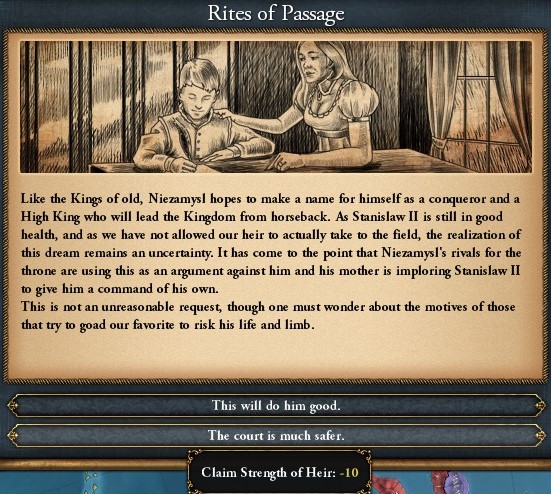
The first enemy to buckle is Ligor in July 1705, strengthening Poland’s hold on Borneo and leaving it with one less flea in its hair to worry about.
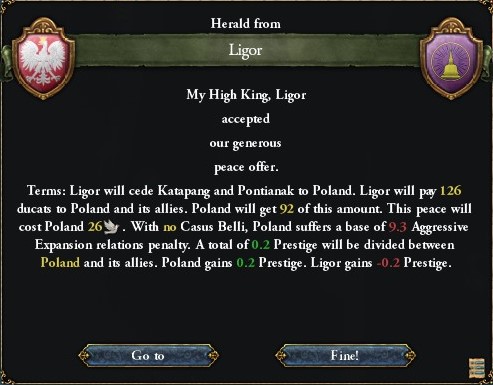
The army departs for Amatica onboard the Black Fleet, improvised for the purpose due to the most of the navy being busy elsewhere, but is caught out near Gibraltar while passing by Asturian territory. In the end, most of the fighting ships have to sacrifice themselves to allow even half of the transports to escape and continue west. Another great farce, though this one Stanislaw II has trouble blaming others for, as he was the one who ordered the Black Fleet – ill-suited for ocean warfare – to be used to begin with.

By the time the remaining reinforcements finally dock in Nowa Antwerpia and link up with the colonial armies, they’re only a blip on the map next to the massive but poorly led militia, albeit a blip led by Gen. Agafia Jastrzebiec, a product of Polish officer training. The colonials are less than happy about her being put in charge of the whole operation, but under her lead, they do start slowly but surely turning the situation around.

The war drags on. In Amatica and Asia alike the terrain is forbidding, distances long and supply lines lacking, making it even slower than it needs to be. At least the European theater remains blissfully quiet, with the Asturians eyeing an invasion of Frisia but wisely deciding against it and retreating. However, in late 1707, when the Frisian army decides to return the favor and scout out the Asturian positions, some malcontents at home take the opportunity to rise up in demand of a new republican government. Grand Duke van Breda is seen as a loyal lackey who either puts Polish interests before the Frisians' or is too busy kowtowing to pay attention, and the republicans believe that a locally elected government is the only thing capable of making Frisia anything but a Polish warhorse. Of course, the Polish troops stationed nearby quickly take care of the rebels, but they might be a worrying hint of things to come.

Gen. Jastrzebiec dies of a combat wound, leading to her speedy replacement by the even more capable Bozislava Dnistri who only lasts a couple years herself. Meanwhile in the Indies, troops under Gen. Drahoslava Ostrogski continue to trudge their way along the Bruneian-controlled Maharlika islands. (Philippines)

A timely large-scale rebellion of Andalusian settlers in Appalachia provides some much-appreciated distraction, but they also end up tangling with the Poles and only slowing down both sides for a while.

Whatever the Poles do, the Asturians are going to end up bleeding them anyway, and Stanislaw II’s efforts to rebuild the mangled navy are actually stopped by the sheer lack of serviceable sailors – and when he tries to enact some harsher conscription laws, they end up getting vetoed by the Sejm. Frustrated by the costly yet fruitless and potentially endless back-and-forth, yet unable to stomach what’d feel like a white peace with the Asturian bastards, in the spring of 1709 – 8 years into the war – he finally gears up for a direct invasion of the Asturian mainland that he wanted so much to avoid.
As Polish troops enter Asturias for yet another slow campaign through the mountains, far more important things might actually be happening right next door. Back in 1647, Italy’s full annexation of France briefly brought up the subject of trying to restore the Roman Empire, and in April 1710, that old speculation is fanned once more as the young and ambitious Queen Gizella I de Serra finally moves her capital from Pavia, where it’s been for over a thousand years, to Rome. She gives a long and dramatic speech about the shameful state that Francia once again finds itself in: falling apart at the seams, repeatedly invaded by Poland and recently even forced to abolish the Senate, the most important part of its government. She stops short of proclaiming any sort of “New Roman Empire”, but makes it clear through her borderline apocalyptic rhetoric just how vital it is that when the dullard in charge of Navarra dies, it is her that should be elected as Empress, and presumably her heirs after her. The elective system was necessary to shake off the Karling yoke for good (and bring on the rise of Italy), but in the centuries since then, it’s become nothing but the instrument of their own destruction.

And yet, if you ask the Electors, the valiant martyr Asturias is actually their favorite at the moment. And Sardinia is still voting for Navarra. The implications of Italy taking over the entire Empire if elected might not be the best campaign speech after all. Still, with the largest members growing and smaller ones disappearing while the imperial government itself withers on the vine, the Queen might have a point.

In one major break from Roman tradition, Gizella I takes the opportunity to declare another major reform: the banning of the slave trade within Italy and all its colonies. Santa Croce and Fiorita alike have been highly reliant on native and African slaves to work their plantations, but with slowing expansion and at the same time growing migration, new shipments of slaves have become less necessary, giving the Queen this chance to grandstand as some kind of historic liberator. Right now the ban only concerns the trade itself, but she hints at a gradual abolition of slavery altogether and economic sanctions against other states that refuse to comply.

Of course, many believe that this is just an underhanded move against Poland. Despite not using many slaves in its own colonies and having long since banned most forms of slavery in its European regions, Poland is in fact the second largest slave trader after Arabia thanks to its control of the West African coast, and abolitionism – should it spread much wider – would be a stinging blow against Slavs and Arabs alike. Stanislaw II, for what it’s worth, is less than interested in either bowing to the Italians or following their example just because.
Back to the war: with the invasion of Asturias, spearheaded by the High King in person, there’s finally some progress being made towards a favorable peace deal (the King would apparently be more than happy to let the fighting in the colonies continue from here to eternity). In the winter months, even Iberia gets its fair share of snow, and general and infantryman alike get to shiver and grumble (though the latter moreso). The actual fighting starts in earnest in December 1710, with nearly 100,000 soldiers on each side clashing in and around Burgos. Not least due to Stanislaw II’s own valor, the result is a series of great if not decisive victories for the Poles.


What is informally and somewhat derisively known as “Stanislaw II’s War” approaches its tenth anniversary, and just as the High King intuitively foretold, the guerrilla ends up being his personal undoing after all. Though he whips his army from victory to victory across Iberia, on 23 July 1711, a small detachment he is leading ends up getting separated from the main force thanks to a critical message being delivered to the wrong address, and by the time this is realized, they are already surrounded. As Christians crawl out from under every rock and tree stump, his men fight valiantly to the death, but as defeat seems inevitable, he recognizes that he is outmatched and seeks to parley. Accidentally or not – no one will ever be able to tell for sure – a cannonball explodes right next to him. His remains are only handed over to the Poles several months later… and in the meantime, his harsh and warlike legacy is passed on to the much more sheltered Niezamysl II, who still has an unpopular war to win.
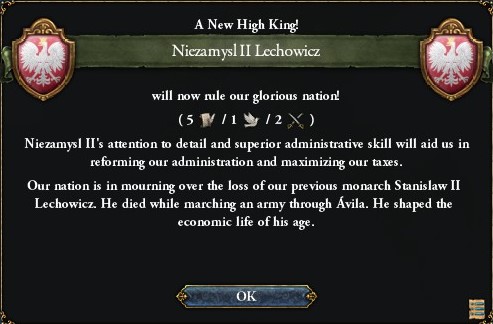
The High King is dead! Long live High King Niezamysl II!


Spoiler: War & Map Highlights
- Germany has conquered not just southern Lorraine, but also most of Provence (previously under Tuscan rule) all the way down to the coast. Several colonial and native powers also took this opportunity to pick off Tuscan outposts around the world.
- England has finally managed to push Munster out of Cornwall and thus the island of Great Britain altogether, but Scotland remains a threat and Lancaster somehow still independent.
- Serbia won the war against Sardinia, acquiring its Greek-culture provinces.
Spoiler: CommentsI’m not screwing up on purpose just to nerf myself, alright? I’m just very bad at worldwide macro. Nice to see that it’s a sufficient handicap to keep me on my toes even while massively overpowered.
Nice to see that it’s a sufficient handicap to keep me on my toes even while massively overpowered.
Also: Unlike Vic 2, I’m not aware of EU4 giving Japan any special bonuses to westernization/catching up on tech. They just… did that anyway. Being the founder of any institution as a non-European nation feels like quite the feat, especially for the AI. On some level I’ve felt tired about Japan being the Asian powerhouse in most grand campaigns/alt-universe AARs I read, but I don’t think I mind it when it’s “deserved”. Well, not that they’re doing as well on the military side.Last edited by SilverLeaf167; 2020-01-17 at 11:06 AM.
-
2020-01-17, 07:18 PM (ISO 8601)Ogre in the Playground


- Join Date
- May 2009
 Re: Paradox AAR - Saga of the Slavs
Re: Paradox AAR - Saga of the Slavs
Managing worldwide wars is indeed tough. I quit a France game because it was stressing me out more than I was enjoying it, honestly.
ithilanor on Steam.
-
2020-01-19, 09:05 AM (ISO 8601)Bugbear in the Playground


- Join Date
- Jun 2010
- Location
- Helsinki, Finland
- Gender

 Re: Paradox AAR - Saga of the Slavs
Re: Paradox AAR - Saga of the Slavs
Chapter #42: When in Rome (Niezamysl II, 1711-1718)
Spoiler: Chapter23 July, 1711
Niezamysl II, 26 years old, has been relatively sheltered ever since his cloaking, as his predecessor was paranoid of him either dying, rebelling or being used against him should he be allowed to roam free or lead an army. However, if Stanislaw II could be seen as some sort of pseudo-rationalist, then Niezamysl II is a true Enlightenment prince in terms of his devotion to knowledge, science and the promotion thereof. Like any High King, he accepts the cruel realities of war, but doesn’t much appreciate them, and would rather end this struggle that has already claimed one ruler and several generals’ lives.


The population seems to agree. Even if war has not touched the mainland Polish population directly, they have certainly “noticed” the number of neighbors and siblings being shipped overseas to fight for some distant colonies that, sure, always sound very nice when the newspapers trumpet the Slavs’ latest conquests, but seem a lot less relevant when someone you know is sent off to die over them. There’s always been some fighting in the colonies, of course, but this has been the largest and longest by far.

The invasion of Iberia, though still promising, suffers some tactical defeats and setbacks which suggest that the war isn’t going to be over anytime soon if the High King doesn’t make it so. And indeed, on 24 December 1711, after precisely 10 years of war, a treaty is finally signed, seemingly bringing only petty border adjustments that leave much of the military unsatisfied but at least finally at peace.
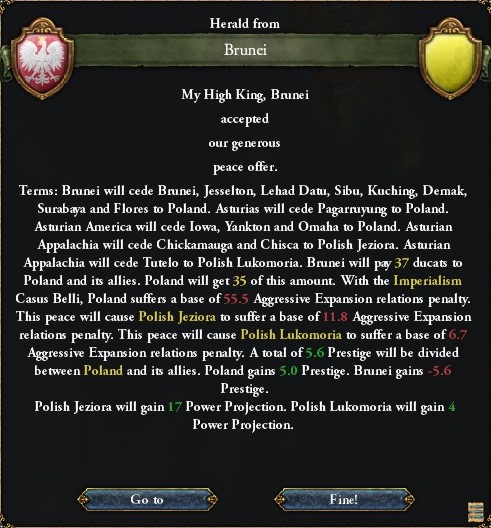

The conquered areas are actually larger than, say, the two Grand Duchies of Pomerania and Lithuania combined, but the difference is that those are European and thus more important. And, to be fair, a lot more densely populated than Amatica. The East Indies do have a large (Sunni and Hindu) population, but Poland tends to treat the islands as a glorified plantation and trading post.

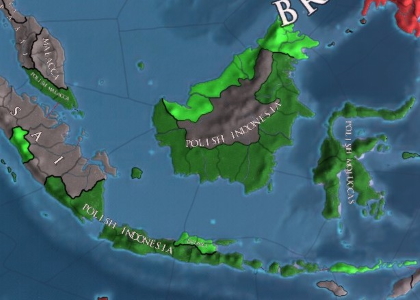
Indeed, despite being a victory in the end, the troubling turns of Stanislaw II’s War have brought up all kinds of new discourse in the Polish sphere: the slow response to the invasion of Nowa Straya. The pathetic performance of the Amatican armies. The arrest and execution of the Voivode of Lukomoria. The intervention of the Crown Army in the colonies’ internal matters. The horrible mishandling of the Black Fleet. The abortive republican uprising in Frisia. And last but still notable, the sheer non-involvement of Moldavia, which was ordered by Stanislaw II to stage a naval operation against Asturias but did literally zero fighting throughout the entire war, not even a single skirmish. The Moldavian Sejm brazenly argues that even if the High King is in charge of foreign policy and can declare war, what they actually do in it still up to them, no matter how clearly this flies against the spirit of the agreement. Especially as Moldavia doesn’t even contribute to the crown economy but in fact receives a number of subsidies, the literally centuries old grumbling about Moldavia exploiting Poland’s protection seems to reemerge, hearkening back to the days when it was still just a Grand Duchy.
Though the Polish colonial empire seems to be creaking a bit, its military should still be large enough to stop anyone from getting any funny ideas, though some doubt has been cast over its strategic competence. Military officials and crown liaisons in the colonies are not helping things by enacting extra taxes, tariffs and conscripts to make up for the resources spent defending them. Whatever the case, Niezamysl II is more than happy to let the situation cool down and refrain from any further conquests for the time being. Big wars like that really should be kept as a once-in-a-generation thing.
Some big readjustments are made to the military: a permanent presence will be established in Amatica and the East Indian garrison doubled, unpopular as this is with the locals and soldiers alike. New troops are recruited in Europe to make up the difference, including every available meczennik to ease the burden on the main population. Also, since a lot of the navy is being rebuilt or at least repaired anyway, it’s a good opportunity to update its heavy ship designs (to be even heavier, naturally).
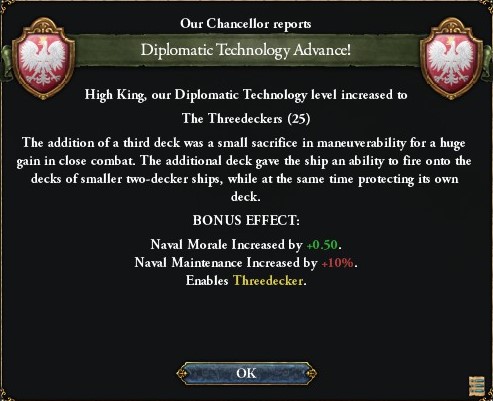
There’s a whole new wave of less than enthusiastic sailors coming in, too, highlighting the importance of propel naval training and doctrine, both of which have received little attention until now. Seeing how good the navy is at just bumbling into a bad position and getting itself sunk immediately, there’s clearly a lot of work to be done in how they work together, both on a ship and a fleet-wide level.


The Queen of Italy has no qualms about exploiting this confusion, discreetly sending envoys and aid to malcontents in Poland’s colonial provinces in hopes that they’ll rebel and at least annoy the High King if nothing else. They seem to try a bit of missionary work on the side, too, but it isn’t too successful.

There should be no risk of Italy taking direct action, though, with the entire Mediterranean having suddenly erupted into a massive war of Rûm and Arabia against Sardinia, Italy and Navarra. Rûm’s main interest lies in Sardinian-controlled Rhodes, but depending on how the war goes, it could potentially lead to a lot bigger conquests in Africa or Greece for instance.

In Asia, another truly continent-wide war starts with Rajasthan and Karnata’s invasion of Wu and Yan. Rajasthan does have a reputation for punching way under its weight, but the balance still looks rather lopsided, and the Indians might end up finally shaking off their long stagnation.

Poland, for what it’s worth, remains nominally at peace. Amatica is in turmoil, though: besides having been thoroughly ravaged by the war, including a lot of fighting in the Jezioran countryside but also the densest parts of Lukomoria (even the capital Bakanów was stormed and occupied), you could say they’re less than happy with Krakow’s policies. They’ve proven perfectly capable of peace and coexistence with their Asturian neighbors, and all of a sudden they’re plunged into war for some land full of oddani they themselves don’t even want (or so they claim)? Many of them or their fathers left for the colonies exactly because they thought they’d get to be free of noble politics and needless war. And though their own armies were quite lackluster, what they saw of the Crown Army wasn’t very impressive either, and there’s a worrying idea brewing that with a little more drilling they could even take their independence by force. So they can go back to being peaceful, of course.
Buyania, the largest and most powerful of the three, is at the forefront of this movement despite taking the least damage in the war itself. Perhaps it hopes to dominate the other two after they break free. In 1715, Voivode Nadbor Kozelski – nearing the end of his first term and perhaps hoping to curry favor with his peers – starts getting more and more shameless, refusing to pay almost any tariffs and even openly supporting people actively agitating for independence. He only stops short of writing the declaration himself. Though hardliners in the Sejm demand that he be dismissed and brought to justice, Niezamysl II seems to favor appeasement and waiting the situation out. Others suspect that a delegation sent to arrest Kozelski very well might not return alive. His boldness does end up winning him a second term, allowing him to continue his provocations in hope of a third.
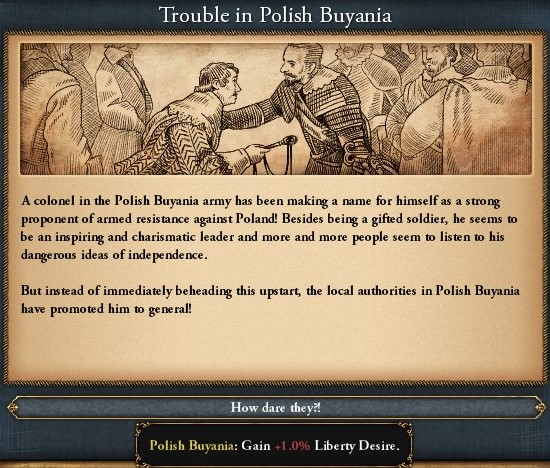
The High King may be a bit erudite and Bohemian (not literally) in nature, but he’s not a fool, and he can see that the situation is extremely delicate. As such, he decides to invest more time into his study of law and political philosophy, though some would argue that his approach is a bit too theoretical to be of much use.

As it happens, Niezamysl II isn’t Bohemian but actually half-Scottish. More specifically, his mother Anna was the third child of King Robert VI of Scotland, who bravely participated in Stanislaw II’s war. So when the first child disappeared under mysterious circumstances, the second died after only two years on the throne, and Anna herself is long dead of consumption, on 23 August 1716, Niezamysl II is informed that he may add “King of Scotland” to his impressive list of titles.

(Help me)
The Scots had first-row seats to witness the chaos of the last war, yet they somehow don’t think to veto this even when Niezamysl II hints that the option is available. They might be thinking that they, much like Moldavia, can simply use Poland as a cover and practically do what they want even while nominally subject to some distant High King. And in that, they’re probably right. Scotland lacks even a parliamentary system, which means that power is now placed in the hands of tiny circle of Edinburgh elites. In trade for their sovereignty, they get greater personal power than ever before, and precisely because the Polish empire has grown so large and complex, Niezamysl II has no choice but to give it to them. It is an interesting contrast with the independence-minded colonies, though.
Well, if they really do handle themselves, that’s fine. Poland is mostly focusing on economic and military reforms anyhow, and unlikely to be especially active in foreign politics for a good while longer.


After several years of fighting, the Mediterranean war ends in an awfully familiar-looking situation as Sardinia is simultaneously overrun by Rûm and Rûm by Italians, both sides deciding to call it a draw.

That leaves Italy with its hands free for what comes next. In early 1718, Germany declares war on Sardinia, in which Navarra intervenes but Italy doesn’t. In March, the 70-something Empress Blanca III finally croaks in her castle, but alas, Gizella I’s hopes are dashed as the Electors end up selecting the Navarran heir Jaime I after all, supposedly impressed by the previous Palafox’ devotion and worried by Italy’s open ambitions. This in spite of the fact that Jaime is a 19-year-old idiot wastrel (as described by Gizella) likely to either bring the whole Empire to ruin or, failing that, spend his reign living up in the mountains on imperial money. The Queen doesn’t much appreciate the fact that the title’s been in Navarra for most of the past century, while Italy, the clearly dominant power of the Empire, has barely gotten to taste it in almost three hundred years.

A few weeks after the Queen storms out of the electorate meeting in Pamplona (having been the only person to vote for herself), she makes a grand announcement: if the other Francians are too foolish to accept her as their ruler, she’ll just make her own Empire! Or more specifically, declare Italy the true and rightful heir of the Roman Empire, much like the Byzantines, Latins and arguably Francians before it. Though she’s reluctant to adopt the name of the Latin Empire, it having been such a total failure, the Italian Empire as she calls it does indeed control most of the ancient Roman heartland, and seems to have interest in the rest as well. As for her own title, it shall be Imperatrix Caesarissa Gissella Augusta – or just Empress or ‘Cesira’ for short. Apparently she was actually flirting with the idea of making Latin the official language, but alas, she doesn’t speak it very well herself.


And in case you missed it, yes, this means Italy is leaving Francia – entirely. None of its territory shall be considered part of the Empire, it shall not participate in imperial matters or the election, and the remaining Francians can probably look forward to what comes next. If there was ever a death blow dealt to Francia, this might be it, on 31 March 1718. What’s left of the Empire mostly consists of Asturias, Sardinia, and a divided gaggle of tiny principalities in increasingly perilous positions. It remains to be seen if Gizella and her successors can really fulfill her bold promises.

(Areas with lines over them are claimed by Francia but owned by non-Francians)
The Kingdom and now Empire of Italy is in many ways a very old-timey feudal nation with strong regional nobility stubbornly clinging to their traditional privileges, yet at the same time, it’s held together by a centralized, efficient and absolutist bureaucracy built around the Cesira herself. Its military is tactically, organizationally and technologically advanced – and almost as large as Poland’s – while the country’s central location has ensured that it remains a prosperous hotspot of trade and intellectual exchange. And as much as she uses Catholicism as a bludgeon to beat her rivals with, the charismatic and militarily minded Cesira isn’t so much a religious zealot as a dangerous opportunist.


Niezamysl II sure is happy to live in such interesting times.

Spoiler: War & Map HighlightsStanislaw II’s War (1701-1711)
Poland + Scotland vs. Brunei + Ligor + Sulu + Asturias
As usual, a war being named after the man who started it isn’t so much a mark of honor as shifting blame. What was expected to be a relatively easy tour of the East Indies ended up devolving into extended, bloody fighting in the wilderness of four continents and, while not necessarily the very first global war, certainly the first one the Poles care about. The Amatican, European and Pacific theaters were largely separate and each area’s own history remembers them differently, but after the back-and-forth in Amatica and the island hopping in the Pacific proved insufficient to make Asturias surrender, Stanislaw II was forced to begin the invasion of Iberia which he’d wanted to avoid, fittingly leading to his own death in the field and a swift peace by his successor Niezamysl II. Though the war itself was a victory, greatly expanding Poland’s colonies in both hemispheres, the aftermath and the events during it led to major reshuffling in the Polish military, as well as increased aspirations for independence in Amatica.

- It seems that after being denied its North Sea coastline, Germany really has been hard at work to strengthen the southern coastline no one knew it had.
- Andalusia is under attack by Kanem Bornu and Tripoli yet again.
- The notoriously rebellious Greeks have risen up once more, this time in Rûman-occupied Crete, and have had it on pretty strict lockdown for a while now.
The greater Lechowicz sphere in 1718. (Click to enlarge)

Spoiler: CommentsDo I look like a Habsburg to you!? I’m thinking that rather than force another breakup, if my PUs stay until Vic 2, I’ll just turn them into alliances and sphere of influence, which is basically how they’re acting anyway.
A shorter chapter, but I just felt like cutting it here and there were some overview things I was eager to get to. A bit of a breather before what I hope will be interesting days to come. There’s also another special coming up.
Much like Heretic Brexit, the whole thing with Italy is shamelessly modded on my part, but… well, so is the Francian Empire as a whole, and again I feel like it makes sense at this point from an in-universe perspective. Besides, no one else worries about me meddling with the events as much as I do. It was actually part of the coding that Italy wouldn’t leave if everyone else finally fell in line, elected it and then let it keep the throne, but for whatever reason everyone refuses to ever vote for it.Last edited by SilverLeaf167; 2020-01-19 at 03:22 PM.
-
2020-01-23, 12:20 PM (ISO 8601)Barbarian in the Playground


- Join Date
- Jun 2007
- Location
- Oxford, England
- Gender

 Re: Paradox AAR - Saga of the Slavs
Re: Paradox AAR - Saga of the Slavs
Just dropping in to say I've been reading up on this since December, and am very interested to see it continue!
BTW, how far forward do the Paradox games extend? Is there a Cold War setting version? Can Poland into space-race?
-
2020-01-23, 02:06 PM (ISO 8601)Bugbear in the Playground


- Join Date
- Jun 2010
- Location
- Helsinki, Finland
- Gender

 Re: Paradox AAR - Saga of the Slavs
Re: Paradox AAR - Saga of the Slavs
Good to have you!
Victoria 2 covers 1836-1936, and then Hearts of Iron 4 covers '36-'50. That's gonna be the end of the direct game-to-game conversion, I'm afraid, but if we ever get there I definitely plan to write an in-depth epilogue.
Poland can into space in the Paradox game Stellaris, but that starts in 2200 and runs on an interstellar scale, so it's more of a spiritual sequel with me having to fill in what happened in those 250 years. But again, should we get that far, I definitely want to at least experiment with it.
-
2020-01-24, 01:43 AM (ISO 8601)Barbarian in the Playground

- Join Date
- Dec 2009
- Location
- Massachusetts
- Gender

 Re: Paradox AAR - Saga of the Slavs
Re: Paradox AAR - Saga of the Slavs
Just want to say I'm really happy this is still going!
-
2020-02-22, 09:50 AM (ISO 8601)Bugbear in the Playground


- Join Date
- Jun 2010
- Location
- Helsinki, Finland
- Gender

 Re: Paradox AAR - Saga of the Slavs
Re: Paradox AAR - Saga of the Slavs
Special #6: Pagans of the World (1718)
Spoiler: OverviewAs the true essence of paganism lies not in the temples, festivals and fancy rituals but everyday life, natural locations, hunting and agriculture and so on, it’s to be expected that the increasingly urbanized upper classes would become somewhat detached from it. Still, the vast majority of the population lives much as they did hundreds of years ago, and their faith shows no sign of stagnating or fading. Even the rise of rationalism has done nothing to create any sort of “atheism”; maybe some deism and a few rare cases of misotheism, but even those aren’t widespread, merely philosophical thought experiments. Of course, denying the existence of the gods (or even any particular god) is among the gravest of crimes against Slavic Church dogma, which ties into its origins as a defense against Christian expansion.

In the general “pan-paganist” worldview, further refined by emerging Enlightenment intelligentsia, there was once some kind of original faith – based somewhere around the Black Sea – that all the present-day religions and their gods then split off from or reinterpreted. In light of this, polytheism reflects the natural state of things, any kind of paganism is more or less close enough, and any two religions can be somehow reconciled. Although, due to their location, the Slavs are obviously closest to the original. This also means that the Abrahamic faiths aren’t merely mistaken: their God (generally identified by Poles as “Jehowa”) is just as real as the others, but in fact a megalomaniac who betrayed every other deity by declaring himself the only one in existence and all the others false.
Thus the struggle between polytheism and monotheism, to those who take it seriously, is a kind of civil war against an evil usurper who would conquer the world and have every other god beheaded if given the chance. Firebrand speakers and even some theologians imagine that every holy war directly reflects the gods’ own battle on some other plane of existence. But, on the flipside, official policy is that since the oddani god is true as well, they can fit into society and even worship Jehowa just fine as long as they don’t cause trouble for the pagans. As if the oddani were ever in the position to oppress them. Besides, the idea that they’re worshipers of a traitor god as opposed to a false one might actually just be worse.
The Poles aren’t terribly interested in “saving” the traitor god’s worshipers, but they do want to protect the pagans of the world from falling under his thrall. Much of this, of course, is simple rhetoric to back up their own colonial ambitions, but most Slavs do believe in at least the basic concept of pan-paganism. On a world-wide scale, it might seem like the religious map is highly fragmented on all sides.
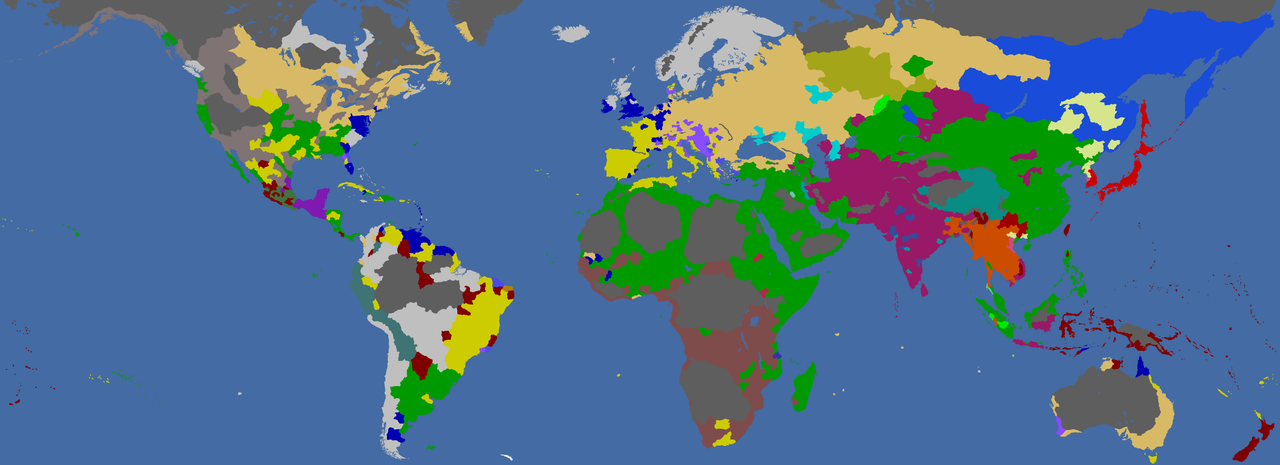
However, when you fudge the boundaries a bit to split the whole world cleanly into polytheists and monotheists…

(Black = Christianity, Judaism, Islam and Sikhism. White = everybody else.)
It’s only natural that the polytheists are winning, seeing as they obviously have more gods on their side. It’s also quite telling that, some local cults aside, the worshipers of Jehowa are really the only major monotheists around. This just further supports the idea that polytheism is the original faith and they the abomination. Luckily, even if Poland’s ideas of pagan unity are both hypocritical and vastly exaggerated, it’s definitely true that the various Jehowa-worshipers are far more dogmatic, ideologically divided, and prone to fighting over small differences in opinion, making it impossible for them to form a united front. Such is the influence of the traitor god.
The paganism of the Slavs and their neighbors has gotten a lot of attention, though, but the fate of their so-called brethren around the world much less so. As more and more of them fall under the influence of one foreign power or another, it’s worth taking a look at how they’re doing – while you still can.
Spoiler: AmaticaThe greatest success story of pan-paganism would have to be Polish Amatica. It’s pointless to try and describe the locals’ religious beliefs in a brief paragraph, since they’re just as diverse as you might expect from a continent covered in diverse cultures, but what matters to the Poles is that they’re pagans and worship a large number of gods and spirits. Only a few groups had (or at least used) writing before the Cyrillic alphabet was introduced to them, and they still seem to prefer oral tradition where possible, but Slavic scholars have devoted miles of paper to documenting them in their quest to prove how all pagans are actually related. The supposedly highest religious authority in the region is the Matriarch of Buyania, appointed really just to appease the clergy, but much like in Europe, the Slavic Church has made little effort to meddle in the locals’ actual beliefs.
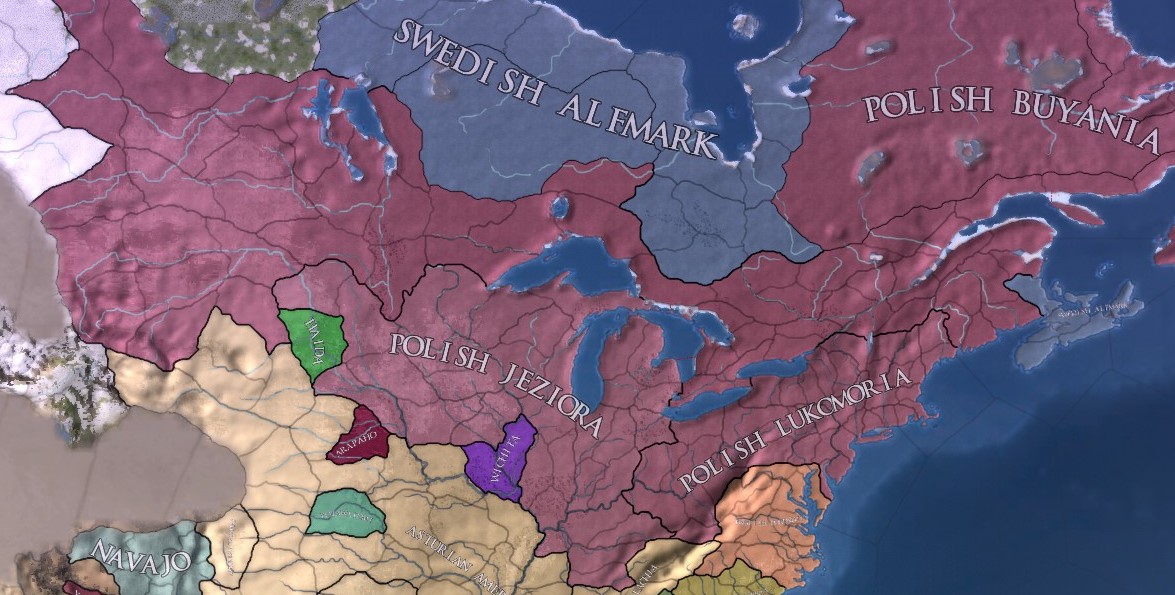
Ever since harmonious first contact, armed conflict between Poles and Native Amaticans has been minimal, and they have been peacefully integrated instead. Of course, that’s glossing over the fact that the settlers have still barged into their lands, taken control of their resources, made themselves the de facto if not official ruling class, and forced countless tribes to choose between assimilation or relocation (often to the far reaches of the continent). Still, even if most of the treaties have been various levels of unequal and backed up by the looming threat of military force should all else fail, it’s certainly a better option than the even less diplomatic methods employed anywhere else.

The natives’ integration into Buyania, Lukomoria and Jeziora has been more so political than cultural or religious in nature. All three have effectively become patchwork federations of settler and tribal territories, each of which is represented in the colonial governments. While most tribes were semi-nomadic hunter-gatherers at the time of first contact, and some of them still choose to roam the vast Buyanian wilderness rather than settle down, a number of them already had highly developed farming civilizations. These were, and still are, especially common in the central region around the Great Lakes and the upstream Mississippi River, which the Poles once nicknamed ‘Little Europe’ for this very reason. In fact, some years after their arrival there was the illusion of all these tribes suddenly adopting European forms of government, but what actually happened was that they simply learned Polish and the Poles learned more about them, revealing just how similar they were from the start.

Large native town in the Jeziora riverlands.
Most of the treaties include Europeans not settling in their lands without permission, but “their lands” are rather narrowly defined so that there are large stretches of “unclaimed” territory left in between, including some rather prime real estate for the Poles to exploit. On the flipside, though, the Polish presence in many wilderness regions such as western and northern Buyania is extremely limited, often including just a few tiny outposts along some waterway that they can use as pretext to claim an area the size of Poland itself. Many of the tribes inhabiting these lands aren’t even aware that they supposedly belong to the Poles now, and don’t really need to be.
Swedish Alfmark has mostly made do with the locals, whereas its northern portion was “practically empty” from the start. To the south, Scottish Hibernia theoretically has policies similar to Poland’s, but the lack of avenues for further expansion has driven the closer (and thus harsher) integration of the native population. The English and Italian colonies, meanwhile, show considerable disdain for the pagans, similar to that of Asturias described below.
Central Amatica and the downstream Mississippi region started out rather similar to the north but were badly depopulated due to the Asturians’ much more direct methods of conquest, conversion and forced resettlement. They too seem to have been influenced by pan-paganism to the point of considering all the natives near the border to be potential traitors, loyal to their pagan brethren. This is something of a self-fulfilling prophecy: out of desperation, many of the natives have fled north into the Polish colonies, eventually settling in, but not without a great deal of demographic crisis on both sides. Unlike African blacks, most of whom are either pagans or Muslims, Native Amaticans aren’t enslaved on a race-wide level, but a lot of them certainly are. Italy’s abolitionist movement has yet to really make waves in the rest of the colonies. The Andalusians, be they those left over from the original Muslim colonies or those who were shipped out of Iberia later on, are awkwardly stuck below Christians yet above the natives in the hierarchy.

The Asturians have also been exerting ever greater pressure in the south of the continent, where fewer and fewer native states still remain independent, driven by the lust for precious metals and fertile terrain.
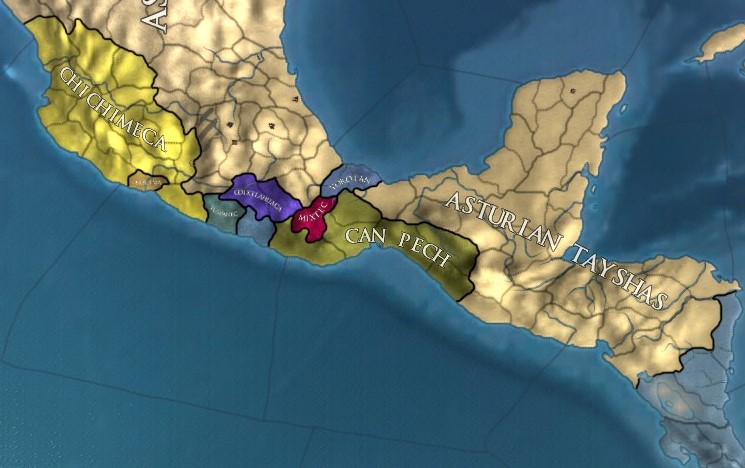
Unfortunately, the ongoing hostilities with the Asturians have made the South Amaticans rather unreceptive to Polish explorers as well, making them hard to study. Asturians claim that they’re also a little too fond of ritual human sacrifice, but, well, we all have our awkward phases. This narrow part of the continent has a large urban population with a long history, far larger than Little Europe, even rivaling the real Europe in places.

Though the Aztec dominion is long past its prime, Tenochtitlan, the Floating Fortress, remains the greatest city in all of Amatica.
And yet, the largest surviving (and still expanding) state is ruled by the Chichimeca, a nomadic people who only recently came from the north and exploited the power vacuum to start conquering the others, not entirely unlike the Mongols in China but on a much smaller scale.
As one travels farther south, the various Nahua and Chichimeca give way to the Maya, Chibchan and other diverse cultures, most of which have been quite thoroughly subjugated. Nowhere is the demographic shift as extreme as in the Zanaras and Ancelles, though, where the Carib people have been almost completely either enslaved, massacred or simply replaced by settlers – and their slaves. The vast majority of the Zanaran population consists of African slaves to work the plantations, kept on a short leash by a tiny white upper class. The sole exception to this rule are the surprisingly still standing “pirate republics” of Tortuga and New Providence, majority Muslim and Nordic respectively, where slavery has been illegal from the start and everyone is equal before the law – or what passes for the law, anyway. Despite their quirks, the pirate republics are certainly not any sort of utopian haven.

Finally, far to the west is Khalifania, the last real Andalusian wilayah colony. The capital Ptolemais (San Francisco), named after the Ptolemee ruling family, is still relatively modest but certainly the most important port this side of Amatica. Due to the deserts and vast mountain ranges in between, there’s little contact with the pagans and Christians – which the Khalifanians are probably happy about – but it’s steadily increasing as the other colonial empires such as Scotland spread along the continent. Khalifania still remains loyal to the Andalusian crown, but it’s doubtful how long that’ll last as the few remaining pieces of the sultanate are eaten up by its neighbors. As for their treatment of the natives, it falls somewhere between Asturias and Poland: quite overbearing, but not constantly hostile. Khalifania also lacks a significant slave population, being more of a wilderness region with few major plantations.

(Rotated 90°)
Spoiler: AlcadraDue to Swedish dominance, paganism is seemingly thriving in Alcadra, but it may be small comfort for the actual natives. If Alfmark was mostly a practice run and quickly became a footnote among the colonies of the world, the Swedish colonies in Alcadra are nothing short of enormous, and enormously valuable. Stretching all the way across the continent from the Panaman isthmus to what used to be Narafidia, the governorates of Ingerland, Paraland, Andeland and Vanaland mostly consist of unexploited or even unexplored jungle, but the coastal parts – especially in the west – also have a large native population and seemingly bottomless supplies of gold, silver and other valuables used to fund great prosperity back in the homeland.
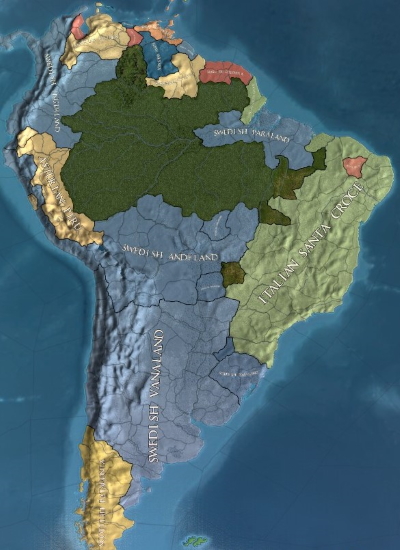

In their drive to extract every crumb of treasure they can, the Swedes, never that interested in Poland’s tolerant ideas to begin with, have not only conquered most of the formerly prosperous Andean civilization but also adopted a policy of actively terrorizing the natives and driving them deeper into the wilderness. Raiding parties formed for this explicit purpose loot and burn their way through any villages caught in their way, sailing up the continent’s myriad rivers in flat-bottomed barges much like the vikings of old. Unlike the mountain cities, the forest-dwellers don’t have much to loot, but the next wave of ships then brings in settlers to take their place, many of those settlers themselves being Sami people evicted from Northern Scandinavia.
The Inca Empire survived almost untouched for a long time, but its final partition by Sweden and Asturias was a – perhaps long anticipated – symbolic defeat for Amatican and Alcadran natives at large. On the other hand, due to the sheer impassability of the terrain, even while their cities were conquered, the Inca have been able to flee into the mountains and maintain their own way of life, at least for now. The fledgling viceroyalty of Peruvia founded by Asturias is in a rather perilous position as well, and might well lead to war between the two colonial empires in the future.

Ruins of an Inca royal estate high in the mountains near Cusco.
Elsewhere in Alcadra, though no part of the continent was truly “uninhabited”, there wasn’t really any other tribal nation large enough to resist the European invaders. Again, however, the natives live on, either separate or mixed with the colonists, and their mixed-blood descendants actually form much of the population of regions such as Santa Croce.
Speaking of Nordic pagans: despite going through a lot of different religions in the Middle Ages and then being part of Poland for a while, Swedish culture has since been eager to stay true to its roots: for instance, though the various Scandinavian languages have long since diverged, the official language of the government remains “Norse” (which people don’t actually speak in real life) and they’re all written in the old Runic alphabet. The period of Polish domination is also seen as somewhat shameful, leading to a constant low-lying tension even despite centuries of peace between the two and making the Swedes even less interested in, or convinced of, pagan solidarity.
Alcadra also includes Scottish Patagonia, which has admittedly been somewhat embarrassing in terms of resources, but it can’t be worse than Scotland itself, right? Scotland’s religious situation is even more complicated than Sweden’s, obviously having had its own pagan traditions before being Christianized for a while and then getting invaded by Norsemen in turn. The Nordic faith is no less strong in Scotland or its colonies, having been dominant for at least 700 years now, but obviously has some local flavor mixed in; even somewhat artificially, since there was a long gap where Scotland’s native paganism was actively suppressed. The Nordic Church as an institution also has its qualms about giving up any of its influence, even in favor of fellow pagans.
Spoiler: AfricaEven though its coast is speckled with increasingly fortified European outposts, Africa remains perhaps the least “conquered” continent. The Muslim faith has been spread by the great Sultanate of Kanem Bornu in the north and Swahili traders in the east, but the vast inland regions remain staunchly pagan – as far as anyone can tell, anyway.

Africa was long known as a source of gold, salt, ivory and other great riches, and that it still is, but as the Europeans learned to sail around it and established a permanent presence on the coast, they’ve become increasingly interested in the slaves and dismissive of anything else the continent can provide. They are only vaguely aware of the size and population of the continent, and apparently don’t especially care to know, either.
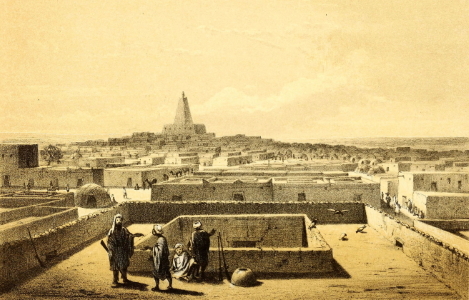

Cities in Kanem Bornu and Benin.
Due to Europeans avoiding the central jungles of “the dark continent” like the plague, most knowledge about African politics comes from second-hand contact with traders (slavers and otherwise) on the coast. Much like the west, the continent is full of smaller tribes, but of the pagan nations large enough to blip on the Europeans’ proverbial radar, Kongo and recently islamicized Sofala are more traditional monarchies, Kuba and Rwanda resemble Europe’s noble republics, and the republics of Benin and Betsimisaraka are somewhat more open (if still dominated by a rich elite).
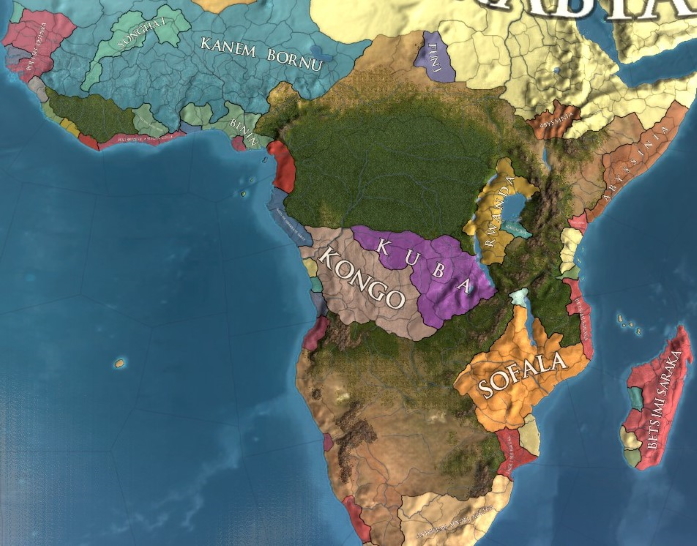
Arabia, which also has several small colonies around the continent, wields tremendous economic and political influence in the east. In the west, Sweden has ended up forging surprising alliances with both Songhai and Benin to prop them up against Kanem aggression. This must be an awkward spot for Benin, which for historical reasons is strongly anti-colonialist and anti-slaver but seems to have little choice if it wants to survive at all.
All in all, how the pagans of Africa are doing depends entirely on what map you want to look at. By some meters they’re under assault by Muslims, fellow pagans and even Christians, but on the other hand, those foreign powers have yet to make any inroads into the vast majority of the region.
Spoiler: AsiaThe classification of Asian “paganism” is in some ways debated, but it’s quite obvious that Hinduism, Buddhism, Shinto, the Tibetan Bön religion and the various traditions surrounding them are polytheist and thus count as pagans by the Poles’ wider definition. The locals themselves don’t really consider the monotheist-polytheist struggle nearly as central, though, and fail to see the meaning of pagan unity in their cultural context.

Compared to the myriad local beliefs of Amatica, Alcadra and Africa, it’s at least somewhat easier to make generalizations about the religions of Asia due to the presence of certain, uh, rather large empires. Hinduism actually covers a vast number of individual local cults and traditions originally from the Indian region, hence the name, but due to the long domination of Rajasthan and the Pratihara dynasty, a certain state religion has emerged. It is centered primarily on Shiva, one of the most important Hindu gods, while still leaving space for others. This is not entirely unlike the Slavic Church itself, where Perun has long been treated as a sort of “first among equals” and the general “default” god to worship. However, despite the fact that Rajasthan rules most of the continent, Hinduism hasn’t really managed to cross the Himalayas onto the Muslim and pagan steppes of the north. It is one of the major religions in the East Indies, though.
Buddhism, Confucianism, Taoism and more form a peculiar bunch of belief systems that are clearly polytheist to some extent, but don’t really seem to care that much, being more focused on philosophical ideas of righteousness and self-improvement than on worshiping the gods themselves. Buddhism is going strong in Indochina, while Confucianism and Taoism are part of the strange hodgepodge that is China itself.
Though the Yuan conquerors were never that popular and have been long since overthrown, their Muslim state religion has stuck around in China, including successor states like Wu and Yan. However, while at least strong enough to warm up their relations with Arabia (given their common enemy in Rajasthan), their brand of Islam has been heavily mixed with the local philosophical traditions and even some polytheist concepts, creating a distinct kind of Sino-Islam that might not be compatible with a stricter reading of the text.
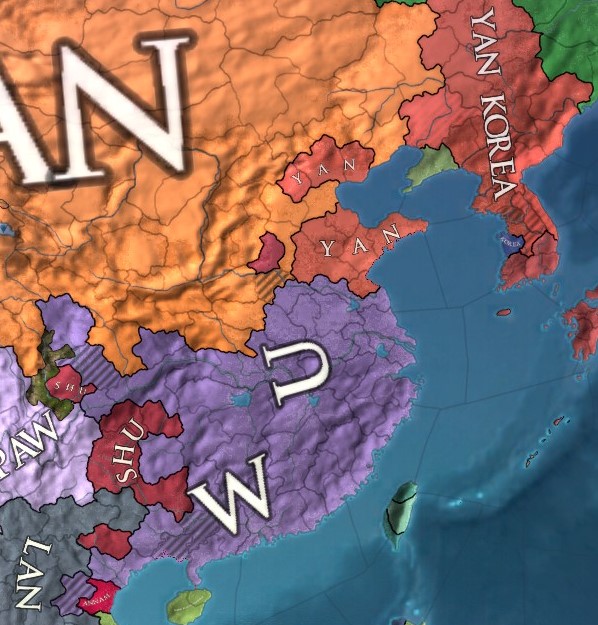
Shinto, meanwhile, resembles Hinduism in that it’s just an umbrella term for myriad Japanese beliefs shaped into a state religion, but the Japanese seem to have even less interest in spreading it abroad. Speaking of which, Japan has been increasingly aligning itself with Rajasthan lately in an attempt to maintain its own sphere of influence in the face of Indian expansion (and their common enemy, the Chinese). Japan has been struggling to balance its opposing goals of scientific progress and cultural isolation, and with a military dictator at the helm, the ruling philosophies and upper classes of Japan are in flux – uncomfortable, awkwardly squirming flux, unable to really change the status quo for the time being.
The Poles too feel kind of awkward about Asia as a whole. Apart from their forceful conquest of the East Indies, their so far rather limited diplomatic, religious and cultural approaches to the continent haven’t borne much fruit. While the prevalence of strong “pagan” states is pleasing to pan-paganist thinkers, the fact that those pagans treat Poland with nothing but disinterest feels almost a bit insulting. If Europeans view their own continent as the center of the world, then so do these Asians, and they seem to have little attention to spare for European visitors when there’s plenty to fight over already.
Spoiler: OceaniaLast but not least… well, except in terms of population… are Nowa Straya and the many islands east of it. Most of the smaller ones remain only barely explored, but presumably pagan, while the main focus has been on Nowa Straya and Aotearoa (New Zealand). Nowa Straya has been quite convincingly claimed by Poland, leaving only a “small” outpost in the hands of Italy. Squeezed off the mainland, Italy has nabbed a number of islands and directed its attention towards Aotearoa instead.

Being deceptively large (comparable to Europe in size) but mostly “empty”, Nowa Straya also hosts a large variety of native peoples, whom the Poles have tried to treat quite similarly to those in Amatica – that is to say, conquered all the same, but more softly so. There’s plenty of outback for those unhappy with the situation to move into, they say, but the outback is the outback because it can’t support a large population. Most people live on the verdant coast instead, the vast inland regions mostly attracting the occasional explorer, prospector – or researcher. Unlike on all the other continents, the Strayans never really established urban centers, but much like in Buyania, a lot of them still live in areas largely untouched or even uncontacted by the colonists who claim them. Partly because the colonization picked up speed during the heavy-handed reign of High King Stanislaw II, Straya also has an unusually large proportion of religious and cultural minorities either encouraged or “encouraged” to move to the other side of the world, making it surprisingly diverse for somewhere so remote.
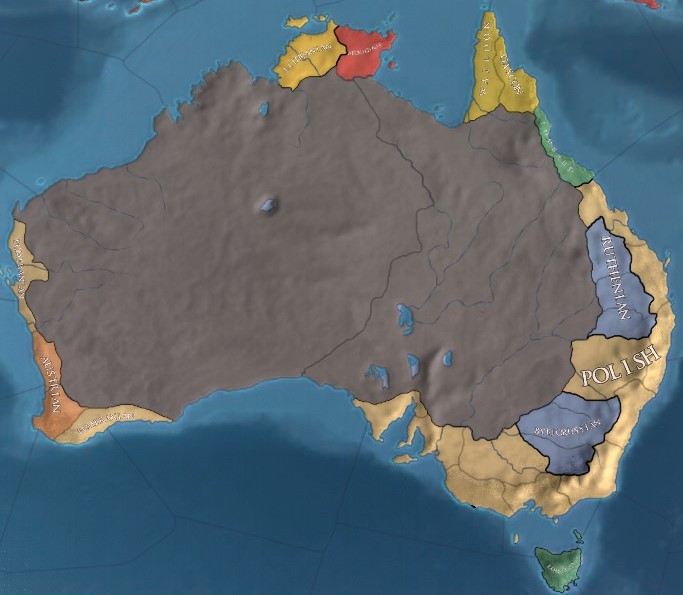
The Viceroyalty of Aotearoa on the other hand is still just a fledgling collection of outposts, and the Poles don’t mind it too much, laughing that the Christians just settled for second when they realized they couldn’t get Straya. The eponymous islands themselves are much smaller than Straya (only about the size of Britannia) but rather densely populated by the native Maori, and the landscape more hospitable. The Italians will in all likelihood get to finish colonizing it in peace and earn themselves a nice little outpost in the far, far southeast of the world.
Spoiler: CommentsAs you presumably noticed, the Playground servers were down for a few weeks, but I couldn’t keep myself from playing so I have a few chapters ready and will be posting them ASAP.
I’ve been neglecting the usual colonial tour, so I figured I’d do something of the sort. But then I can’t help but feel like it turned out kinda long, winding and unfocused, and I wasn’t actually going to start talking that much about the contents of the religions themselves, so the theme is kinda unclear. Besides what I said about them being incredibly diverse, in the end, that’s what Google is for. I also feel like I’ve been talking a lot about how massive some areas are. It’s just something I’ve been thinking about lately, since a lot of people tend to underestimate the size of Australia and New Zealand for instance, never mind the other colonies and so on.
I also feel like I’ve been talking a lot about how massive some areas are. It’s just something I’ve been thinking about lately, since a lot of people tend to underestimate the size of Australia and New Zealand for instance, never mind the other colonies and so on.
In an alternate universe where we went for a more zealous route instead of the Humanist one, we’d probably still have pan-paganism but the conclusion drawn from it would be vastly different. Not so much this “all gods are the same so they’re all cool” but instead “all gods are the same so let’s go teach people how to worship them properly”. I think pan-paganism is a strictly fictional concept made up by myself. But I do know it is nonsense, both in the game and in real life. In case that wasn’t clear. Very historical nonsense, though, if you look at the sorts of theories proto-anthropologists, linguists and theologians liked to throw around in the 17th-18th centuries.
Very historical nonsense, though, if you look at the sorts of theories proto-anthropologists, linguists and theologians liked to throw around in the 17th-18th centuries.
Sidenote: If you look closely, you can see that the Pacific islands are already almost done getting colonized too. I’m gonna wipe most of them clean in the Vic 2 conversion, because otherwise there’s just gonna be barely anything left to colonize, especially since I plan on keeping the native countries in Africa. The islands aren’t “supposed to” be colonized until the late 1800’s, anyway.Last edited by SilverLeaf167; 2021-01-17 at 07:04 AM.
-
2020-02-22, 01:30 PM (ISO 8601)Bugbear in the Playground


- Join Date
- Jun 2010
- Location
- Helsinki, Finland
- Gender

 Re: Paradox AAR - Saga of the Slavs
Re: Paradox AAR - Saga of the Slavs
Chapter #43: So Many Emperors, Only One Europe (Niezamysl II, 1718-1734)
Spoiler: Chapter1 April, 1718
With Cesira Gizella I’s announcement of the Italian Empire, everyone’s waiting to see what happens next – or if this ends up being yet another bit of empty bluster that anyone dealing with the Christians has long since gotten used to. “Francia is about to fall” has never left the Polish popular lexicon, and for good reason, but every subsequent upheaval in the last few centuries has in fact seemed bigger and more permanent than the last. Francia never quite recovered from the Heretics’ War and the secession of Britannia, for one.
Right next door, Germany-Vladimir’s invasion of Sardinia is just getting started and about to pit them against most of what remains of the Francian Empire now that Italy has left.

As the Cesira starts demanding that the Francian powers withdraw their diplomats from Romagna even though it’s still a member state and even involved in the war against Germany, it’s not difficult to guess what’s coming.
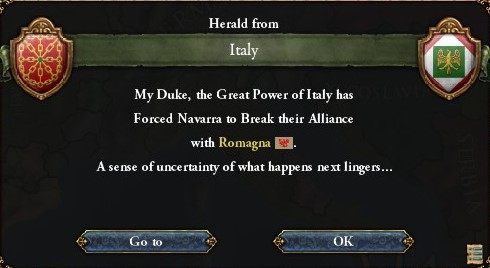

Italy has long tolerated the presence of smaller states such as Romagna, Tuscany and Venice on its turf, but having officially separated from Francia and vowed to become the new, much stronger heir to the Roman Empire, that tolerance seems to have run out. Navarra’s policy of half-hearted appeasement fails to stop Italy from starting its first (and probably very short) war against Francia. Well, more specifically Navarra and Asturias. Most other member states have either already made alliances with Italy or decided to just stay out of what would surely be a suicidal effort.

Meanwhile, having occupied the island for a good while now, the separatists in Crete declare themselves an independent Greek state (and the only officially Cathar state in the world). There’s been a lot of supposed successors of Greece over the years, though, and few have lasted very long.
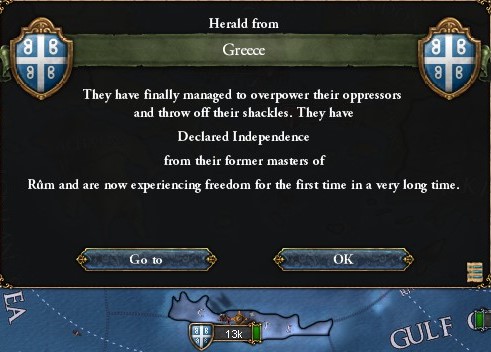
Indeed, some years later the nascent Greek state will be once again annexed by Rûm. A new one’s already brewing on Sardinian Rhodes, though, and the cycle continues.
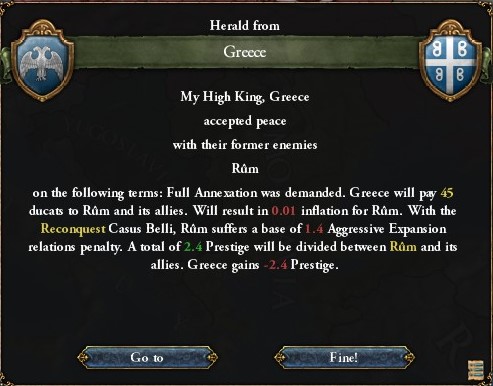
But back to today: Most of Andalusia (if you want to call it that) is annexed by Kanem Bornu, the country goes bankrupt again, and so on. As far as anyone is concerned, the various territories (mostly outlying islands) that Andalusia still lays claim to are either practically independent or under the rule of rebellious warlords.

Poland doesn’t have much to laugh about in that regard, though. It turns out that the Scottish port in Jamaica has become overrun by pirates, the colonial administration having originally sheltered them on purpose but eventually gotten kicked off their own island, which has now declared itself yet another “pirate republic”. It’s Scotland’s fault for neglecting it, really. High King Niezamysl II doesn’t have much interest in starting a naval war with the pirates just to deal with it, especially when a lot of the pirates operating in the Zanaras are actually on Poland’s payroll.


(I later edited the culture and religion to match Scotland’s and not mine)
A couple years go by. Under the combined onslaught of Germany, Itally and their allies, Navarra and Asturias are quickly overrun and Iberia thoroughly occupied once again. At the same time, rather than waste time and money on warfare, Niezamysl II focuses on the funding of Poland’s education and government institutions, accompanied by relatively piddling legal reforms.

His bored and frustrated generals try a new approach to get more funding of their own, pitching a project for a life-sized recreation of the Battle of Reinholdsburg of 1297. Fought between High King Trojden I and the Teutonic Order on the fields of Jylland, it was the largest battle in Polish history up to that point, a total of 120,000 soldiers facing each other in a single pitched battle to the death. The battle was a crushing victory for the Poles and led to a swift end for the war, but what matters now is that the generals want to put that same amount of men in old armor and do it again for the benefit of military theory and history alike. A scientist as well as a friend of the performing arts at heart, Niezamysl II accepts their suggestion, gives them all the funding they need for their massive undertaking, and obviously attends the event himself, accompanied by dignitaries from every European country that’d accept his invitation.

It takes until 1722 for the (real) Mediterranean wars to be well and truly over, with Romagna being fully annexed as expected, both invaders taking pieces of Navarra, and Germany strengthening its presence in the western part of the sea. Germany’s decision to drive such a disruptive wedge into the middle of Italy’s would-be dominion is sure to further escalate their already hostile relationship, though.

Niezamysl II’s advisors use this new wave of expansion as proof of the urgency of their long-awaited invasion of Serbia. He still has little interest in such things, but Yugoslavia has indeed proven surprisingly stable for now and it seems unlikely that anyone will come to Serbia’s aid, so he finally agrees that it really would be better to grab it before somebody else does. Troops, already in place, cross the border in April 1722 with barely a declaration of war.

Italy, as expected, directs its imperialistic tendencies elsewhere.

The invasion of Serbia is a routine affair, over by the end of the year. It’d be easy to just annex the entire country into Yugoslavia, but the High King thinks otherwise. As a result of its centuries-long back-and-forth of conquests and rebellions, the region is a jumbled mess of Serbians, Bosnians, Greeks, Italian settlers and more – not to mention their equally diverse religions – but partly to maintain Yugoslavia’s vanishingly thin veneer of legitimacy, partly to try and keep it stable, Niezamysl II decides to leave out the Greek-majority region in the south that would’ve blatantly gone against those principles. Yugoslavia’s mandate has thus been quite thoroughly fulfilled and the Southern Slavs “united” under Polish leadership… with the exception of Italian Dalmatia.

(Maximum warscore didn’t let me take both of those remaining provinces, so I opted for neither)
Yugoslavian officials soon come asking for privileges quite similar to those that Frisia keeps whining about, namely assurances of their permanent “independence” and lower taxation in return for greater military contribution. Niezamysl II is happy to grant this, as is the Sejm, still somewhat split on whether Yugoslavia was such a good idea to begin with and having little interest in annexing it. The unspoken implication is that they’re not wanted as a part of the nation, just as a buffer state and blatant power play. Frisian demands for the same are once again rebuked, though.

In 1724, Asturias seizes most of Andalusia’s remaining claims but perhaps most dramatically the colony of Khalifania, which had remained almost miraculously loyal all the way until now. It’s a whole lot of wilderness, supposedly hiding glorious gold deposits that just have yet to show themselves (never heard that one before), but is also Muslim through and through. It remains to be seen how Asturias decides to handle its administration in the end.

In fact, a lot of its colonies in other parts of Amatica aren’t doing so well, having to deal with long-running unrest among Muslims and natives alike, from north to south.

Poland’s own bellicose parliament has a whole new problem on its hands, though, when in January 1725, diplomats from Chernigov come requesting (mostly assuming) Polish aid in a renewed invasion of Rûm to continue where they left off. However, even though it’s been 28 years since the end of that last bloody, bloody war and the legend of Dervis Gümülcineli the Impaler, it remains a truly sore subject even with those too young to actually remember it, not to mention those who do. Perhaps even more importantly, the Poles feel that they have nothing to gain from this war, never mind that the Moldavians (who arguably do) seem reluctant to do any fighting either.
As a result, the Sejm protests to the High King, who is content even if a bit embarrassed to refuse Chernigov’s invitation. This costs him the alliance with Chernigov, but it’s been a long time since there was any real fighting between the Slavs themselves, and people have either forgotten the threat or simply consider it a thing of the past. Besides, Poland still has an alliance with Novgorod, not to mention its own subject states and overall overwhelming military might.

Not entering this massive war lets the Polish military keep focusing on internal reforms instead. The Marynarka has been figuratively and literally rebuilt after taking a severe beating in Stanislaw II’s War, and now consists of four main battle fleets (the Black, Atlantic and Indian Fleets and the Grand Marynarka) as well as over a hundred light ships on trade patrol duty. Making this happen has required not just a massive expansion of Poland’s shipbuilding facilities, but also new investments in ship design to hopefully keep these ones afloat for a while longer.

Other manufactories have also needed to adjust to the massive demand for cannons to put on the new ships, the military making both technical and tactical breakthroughs in their use along the way. Although still expensive and often inconvenient to move, massed artillery has proven its worth over the years in saving Polish lives and making the enemy die faster from farther away.
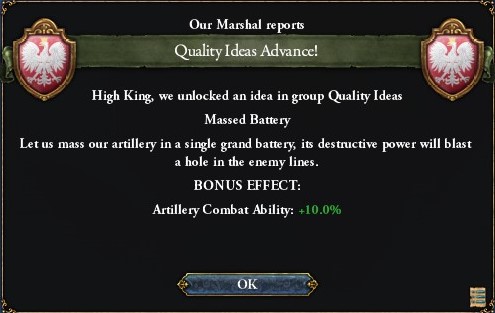

In 1727, word arrives that the Zanaras are getting a little cramped and that the Republic of Tortuga – fuzzy as these states are to begin with – has landed in and conquered Port Royal. A lot of people all around Europe are debating whether they really should just sail in and restore order to these tiny provinces, but so far everyone seems to have calculated that the pirates are hurting their enemies more than them.

The Cesira, citing her secondary title as Queen of France, marches into the rich and storied Republic of Normandy and forces it to bend the knee in return for keeping its autonomy. Small states continue to disappear off the map all around the world.

In 1729, Chernigov’s borders move southwards once again after four bloody years of war that Poland is glad to have avoided, though the Sejm is starting to have second thoughts about having refused so rudely and cost themselves an ally.
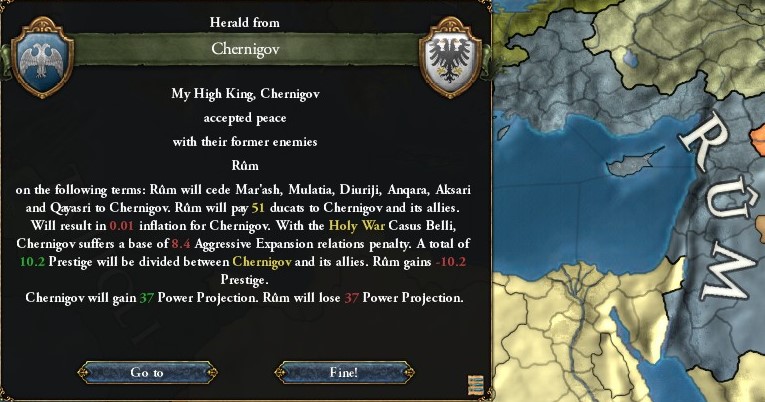
But though militarists may grumble, Niezamysl II understands that the same laws of rationalism that some use to advocate for war actually provide far more arguments for peace, saving money and building up mutually beneficial trade relations. Separatist voices calling for independence have become the norm in Amatica and Frisia alike, but they’ve sort of lost their sense of urgency after talking about it for twenty years now (though obviously someone else might say that the persistence of this issue actually makes it far more worrying). The regent governments in Moldavia and Scotland, on the other hand, continue to happily breeze along under Polish protection. The Sejm too has little to complain about as the High King gives them more and more say in daily matters and policy, trusting in their loyalty and competence that he doesn’t need to hoard all power for himself.

Of course, the military continues to swallow up most of the crown budget, not least because so much of Poland’s economy, or even society, is focused around it. It’s impossible to even consider the side-effects of trying to reduce it. In peacetime like this, the Crown Army is out either drilling, parading, maintaining public order or just providing muscle for various construction projects, including large fortresses and protected harbors in the colonies where about a third of it is garrisoned. This serves as an assurance to the Voivodeships that they won’t be neglected again, but also as a way to strengthen the motherland’s grip on them and ensure that any local troublemakers will be swiftly put down.

Military development, not just quantity but also quality-wise, continues its endless march.
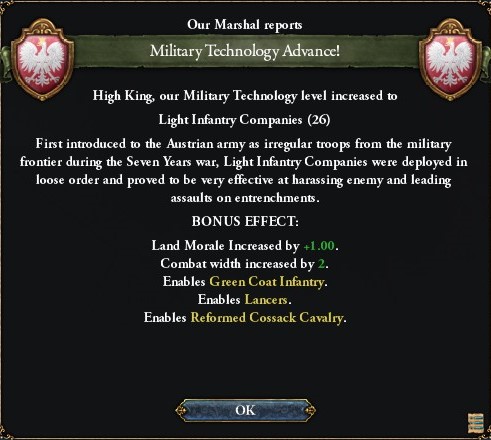
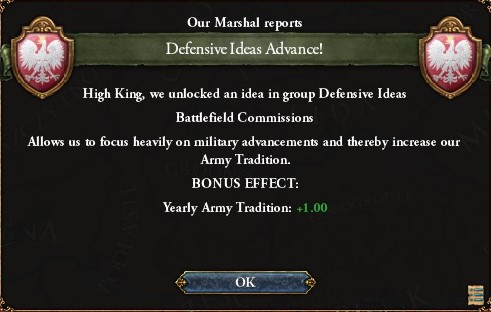
Even Chernigov seems to forgive Poland for breaking their alliance – they did win the war, after all – extending an offer to renew it in 1733. The Sejm accepts, though obviously this just teaches them that they have the option of breaking it again with no real consequences.

It also opens their eyes to certain new possibilities. Without the High King actually being informed, something almost resembling a conspiracy (perish the thought!) forms inside the Sejm, coordinating their efforts to use entirely legal means to channel military funds into a carefully selected set of projects.
They see their chance in March 1734: the Cesira, seemingly invincible and increasingly bold, declares war on Asturias, hoping to seize not only several colonies but also some more of the Mediterranean to cement her claim to Christendom.

The way the Sejm would put it, this is the perfect time to take Italy down a notch before it really becomes a threat to Poland. Though it’s been a surprisingly long time since Poland and Italy were at war, and the Christians have been far busier fighting each other, a clear hostility persists in both sides’ rhetoric and the three main power blocs of Poland, Germany and Italy can find no common ground. 49-year-old Niezamysl II still remains unsure, seemingly happy to stay at peace for the rest of his life if possible, but the trust and power he has given to the Sejm leaves him with little choice but to bow to their judgment when the nobility votes overwhelmingly in favor.
As of April 1734, Poland and Italy are in a state of war. Besides their respective subjects, Poland is joined by Chernigov and Italy by a couple minor republics of no importance.

At the High King’s insistence, the generals and the Sejm have put together a clear and enumerated list of what Poland actually hopes to achieve in the eventual peace deal, in order of priority:
- Italian Dalmatia to Yugoslavia
- Italian Terregina (Queensland) to Nowa Straya
- Italian Greece to Moldavia
- Italian Fiorita to Hibernia
- Various island outposts and other targets of opportunity
It’s a lot of things, and who knows if they actually think they can achieve all of them. While the Crown Army and Marynarka are both larger and stronger than ever, Stanislaw II’s War against Asturias taught them a serious lesson that worldwide colonial warfare is no walk in the park, not to mention that Poland’s subject states aren’t too happy about being dragged into it, even if many of them stand to gain. Thus begins another global war, this time between two of the true superpowers of Europe. One can only hope that historians will give it a flattering name.

Spoiler: CommentsI didn’t put the idea group to a vote because of the server outage, but there aren’t that many “good” groups left to choose from anyway. On that note: I’m really bad at thinking about/realizing when to give you guys a vote on something, so if you have any broad suggestions on that topic (now that the boards are back up), I’d appreciate it. So far we’ve really only had the idea groups and the Germany vote way back in CK2, and obviously we’re not even gonna have those going forward.
I notice the years fly by and kinda have to acknowledge that I may have prematurely entered the “endgame” mindset, especially since I’ve been working on the Vic 2 conversion on the side (there’s a looot of tweaking to do even before the final map layout is known, and the more you do the more you find). But there’s still around a century to go and all, so rather than just hope that some other country does something interesting, I decided I had to be active myself. By the way, normally EU4 ends in 1821 and Vic 2 starts in 1836, but it’s far easier mechanically to keep playing EU4 past the time limit than edit Vic 2 to start earlier. So we’ll be here until 1836.
I realized somewhere partway through the game that I might have wanted to turn up the difficulty at the start to make the AI a bit more proactive, but unfortunately it’s far too late for that. I’ll just have to remember in Vic 2.
I’ll just have to remember in Vic 2.Last edited by SilverLeaf167; 2020-02-23 at 11:41 AM.
-
2020-02-22, 03:43 PM (ISO 8601)Ogre in the Playground


- Join Date
- May 2009
 Re: Paradox AAR - Saga of the Slavs
Re: Paradox AAR - Saga of the Slavs
Paganism overview: very interesting historical nonsense! It also makes me happy that in this alternate universe, there's been a ton of efforts to document Native
AmericanAmatican traditions rather than just wiping them out.
Regular update: I'm...kind of excited for this war? Whatever way it goes, there should be major changes in-universe, and I anticipate the Poland-Italy conflict driving the endgame dynamics.
ithilanor on Steam.
Whatever way it goes, there should be major changes in-universe, and I anticipate the Poland-Italy conflict driving the endgame dynamics.
ithilanor on Steam.
-
2020-02-26, 10:28 AM (ISO 8601)Bugbear in the Playground


- Join Date
- Jun 2010
- Location
- Helsinki, Finland
- Gender

 Re: Paradox AAR - Saga of the Slavs
Re: Paradox AAR - Saga of the Slavs
Chapter #44: The Dalmatian War (Niezamysl II, 1734-1738)
Spoiler: Chapter1 April, 1734
Poland and the Italian Empire are at war, and people can’t seem to agree on whether they’d prefer to paint it as a routine affair or an epic struggle for dominance. Its start definitely was a matter of pure pragmatism, but also a long time coming. What matters to them is that just looking at the numbers, Poland’s side is estimated to have at least twice as many troops; alas, it’s not necessarily that straight-forward. Many of Poland’s myriad subject states are either insubordinate or inconveniently located, and looking at just Poland vs. Italy for instance shrinks the difference to a much more swingy 328,000 against 250,000. Then consider that about a third of Poland’s military is positioned in the colonies, and that the distribution of Italy’s own troops isn’t known, and it really could go either way – though the Poles are obviously confident that they can win without much issue.

Italy having just declared war on Asturias should also help split its attention, even if Asturias alone would be barely a speedbump, and Germany right in the middle should be unwilling to grant passage to any of the belligerents, disrupting Italian troop movements while securing much of Poland’s long border. That still leaves Frisia and the Balkans as likely battlefields, though, and Italy’s Mediterranean navy is nothing to sneeze at either.

The first real battle (and crushing victory) of the war is actually against one of the “lesser” enemies, namely the Republic of Cologne that Poland wants to swiftly occupy and either knock out of the war or basically take hostage for the coming negotiations. With a third of the Colognian army getting wiped out on its foolish foray into Frisia, that goal is certainly off to a good start.
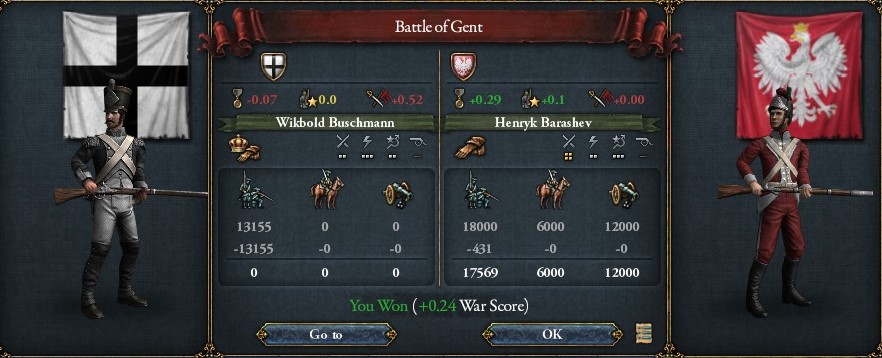
Italy gets swift retribution by sinking much of Moldavia’s navy in the middle of the Aegean Sea. Luckily this massive armada doesn’t seem to include any troop transports, so a naval invasion shouldn’t be imminent, but the High King is forced to keep some troops in reserve nonetheless. The Black Fleet is hiding safe and sound in port, basically yielding naval dominance to the Italians.

Of course, if the attack isn’t coming from the south, that bodes badly for the north. Much like Poland’s previous Balkan wars, the advance into Greece and Dalmatia is nigh unresisted, with Crown Prince Aleksander leading the almost ceremonial march inside, but the fighting really starts in earnest in July 1734. What must be most of the enemy military rolls into Frisia and Cologne, and as has happened before, Poland proves a little unprepared due to having split up its forces across the front. Poland’s first setback in this war isn’t a crushing one, but it still stings, and forces Gen. Zelibrat Lechowicz to abandon his siege of Köln.

Far worse disasters follow as his colleague Prendota Lechowicz seeks a rematch, only for the enemy side to get timely reinforcements while his own get ambushed and caught up by another force making use of its home field advantage. At least the Poles are also able to retreat into home territory, but Frisia is left to suffer the worst of the Italian offense yet again, as is the usual fate of a buffer state.

With almost 200,000 Christian soldiers roaming the region by the start of 1735, it seems that Italy has indeed decided to mostly ignore Asturias until this threat has been dealt with, which is probably a wise decision. Luckily the massive fortifications in Calais and Antwerp are perhaps the best in the world and unlikely to fall anytime soon.
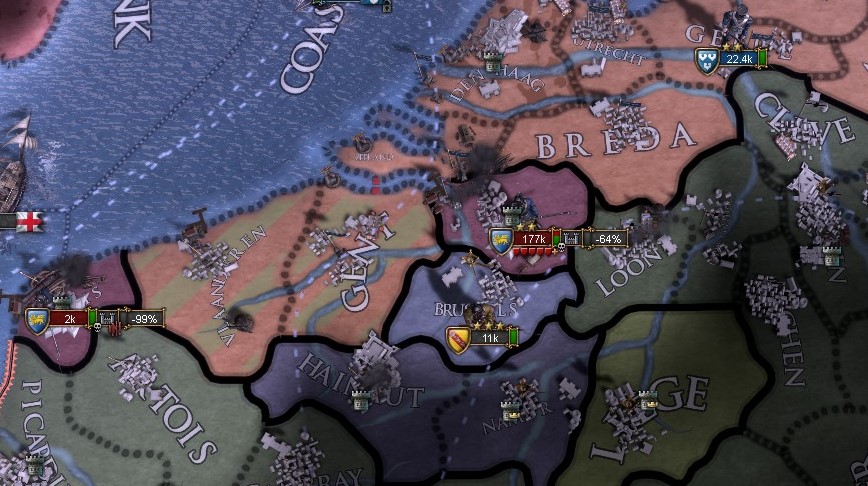
At least Hibernia and the Amatican garrison don’t have much trouble occupying Fiorita. Asturian envoys soon arrive to kindly request that the occupation be handed over to them, but are unsurprisingly laughed at until they leave. On the other side of the world, Terregina falls with similar ease.

Speaking of the colonies, there’s (perhaps surprisingly) some fighting as far south as Patagonia as well, with a small detachment from Santa Croce making a landing near the capital. It will go on to occupy the entire colony, the other fronts being too busy to send any reinforcements.

Almost a year after their original defeats, in June 1735, the recovered Poles return to find a small Venetian force seemingly abandoned by its allies and quickly wiped out. It appears that the command structure of the Italian army, rapidly expanded in the past decades, has trouble dealing with a large two-front war and can't seem to either properly commit to one front or split its forces between the two, leading to a lot of decision paralysis, conflicting orders and ultimately the worst of both worlds.

Also, even though Poland is on rather bad terms with the Germans, Chernigov actually remains their somewhat tenuous ally. The general arrangement is that Chernigov maintains alliances with Poland, Germany and Sweden and vows to defend whichever of them is attacked by one of the others. Leaning on this, and with more than a bit of pressure – threatening to stop securing Germany against Polish aggression – King Gleb II Artamonovich succeeds in securing passage not just for his own forces but the Poles and their subjects as well, allowing them to start invading in force.
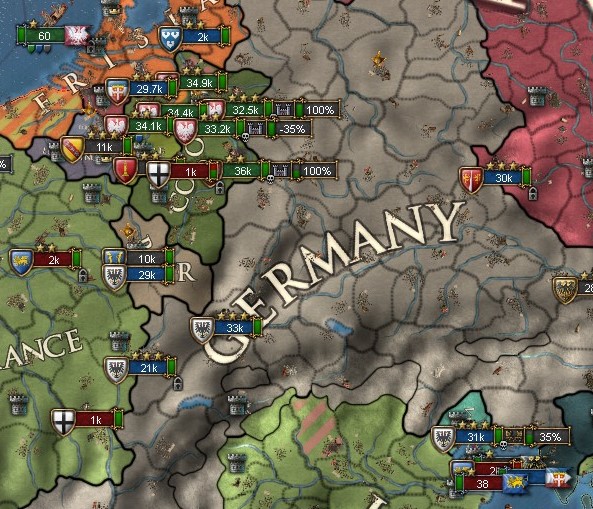
The first cracks in the Italian alliance appear near the end of the year as the Venetians, their armies annihilated and their serene cities besieged, try to strike a separate peace. Niezamysl II, actively trying to dodge responsibility for this war (perhaps not the most king-like thing to do), puts the offer to the Sejm. The Sejm, having apparently embraced the “hostage” strategy and wanting to loot the various republics for all they’re worth, declines.
The notorious Cesira Gizella on the other hand would very much like to be leading her armies in person, but the antiquated customs of Christendom won’t let her, even if they’ll suffer her to rule. She’s probably happy to have moved her capital to Rome, at least, when Slavic armies finally start pouring into northern Italy. However, soon they are driven back by the arrival of the seemingly larger-than-ever Italian armies. Later analysis will show that both sides’ armies actually grew over the course of this war, having never needed to utilize their full military capacity before but now rushing to outgun each other by scrounging up every man they’ve got.

After their initial failures, the Poles’ own strategy is now more cautious, making sure to secure Cologne before venturing any further into enemy territory, which they achieve by July 1736. Unlike with Venice, however, they’ve started to reconsider their hostage policy: Cologne still has around 60,000 soldiers roaming around helping Italy, so taking them out of the war would in fact be very much worthwhile. And that’s what they do, forcing upon them a separate peace that includes the secession of two Flemish-majority provinces to Frisia, as well as various other ordinances to make sure the war against Italy can continue unhindered.

Now the Poles debate whether to focus on France in an attempt to cause some devastation and perhaps whip up separatist sentiment once again, or to forget about tricks they’ve already tried and just strike for Italy proper. As that wording might imply, they choose the latter. Making use of an Alpine pass previously secured by the Moldavians, they roll into the Po River valley, and the former capital Pavia falls in about a month. The defenders are running around somewhere, and to an optimist, it seems like the way to Rome might lie open.
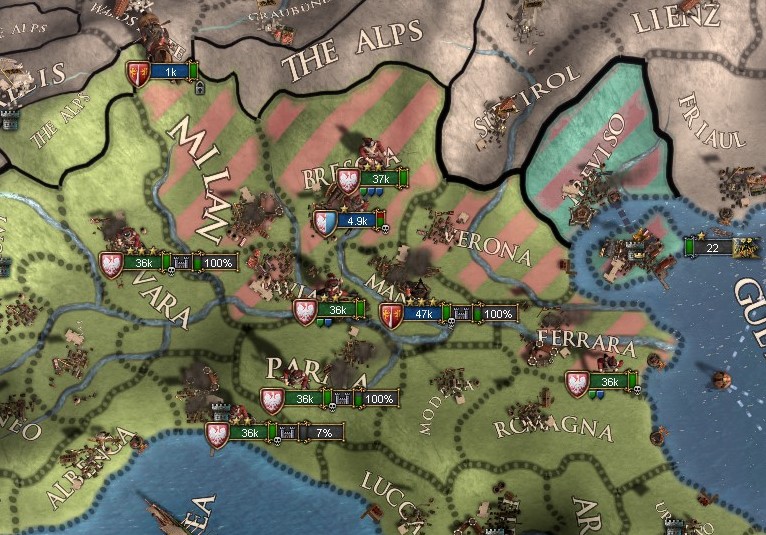
Even Scotland finally deigns to do something, launching an easy invasion of Brittany.
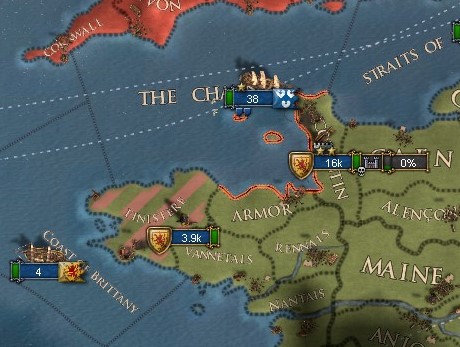
The High King also seems to be trying to return to daily routine, approving a splendid initiative from the clergy to start investing more in local, lower-class education in addition to the distinctly upper-class universities. He would much rather go down in history for things like this.

The East Indies garrison, apparently bored after uneventfully occupying the colonies in the region, ends up sailing as far as the Italian outpost in northern China. Not that it requires much more than just barging in and declaring it theirs, being defended only by a token peacekeeping force. The Chinese locals groan at the prospect of having to learn another European language.

By the summer of 1737, Poles are knocking on the gates of Rome, but they knock a little too hard and the gates fall down.

Crown Prince Aleksander Lechowicz was clad in traditional red-and-white plate armor polished to a mirror finish, something that Christian commanders had eschewed in favor of lighter (though honestly no more practical) fabric dress. It was largely a ceremonial garb for him as well – quite tellingly, only his personal retinue was armored while all the other soldiers were in more regular uniform – but the Poles were of the opinion that a warrior, even a backline commander of hundreds of thousands, should present themselves accordingly on such an occasion. Some of his fellow generals, not least Zelibrat and Prendota Lechowicz, couldn’t help but feel like he’d just come waltzing in after the real fighting was already done and stolen their thunder, but that wasn’t entirely true: after leading the attack into Dalmatia, he had immediately marched his troops up north to, as he would put it, bail them out of the mess they’d made, and participated in several battles throughout the war. A well-educated, strong and handsome man in his prime, he cut a striking figure as the hooves of his Khazarian destrier clopped against the shining marble of the recently restored Piazza del Quirinale, followed by a column of red-coated soldiers marching in tight lockstep.
At his insistence, this event was being held not out in some field, not hidden in some conference chambers, but right here in front of the imperial palace where all the gawking citizens could see it with their own eyes, lining the streets and filling every window. It was always a big event, usually not pleasant, when an invading force marched into town, but some invasions had more symbolical value than others. The reception didn’t keep him waiting: at the same moment that he and his convoy stopped in the middle of the piazza, the doors of the Quirinal Palace flew open and Aleksander became the first Polish royal to lie eyes on the fabled Cesira in person. Christian and Slavic propaganda alike tended to paint her as something of a stubborn, megalomaniac shrew of a woman who quit Francia and went on a conquering spree out of sheer spite for not getting what she wanted, but her success was undeniable, and so was the aura of a real leader around her. Aleksander thought to himself that in a different age, she could well have been the Christian Grzymislawa, but fate had thought different. And yet, her robes of imperial purple were decorated with plates of steel to give them the appearance of armor as well. As she and her retinue approached and stopped in front of Aleksander, the 50-something Cesira took a long, hateful look at him astride his horse.
“Your king won’t give me the pleasure of spitting in his face?” she spat out in Latin.
“The High King has more important matters to attend to,” Aleksander answered, also in Latin.
Gizella scoffed. “Your tongue disgraces the language of God, savage.”
“As you wish. Mam więcej bogów niż ty, cesarzowa, i wiem w jakim języku mówią.”
She gave him a puzzled look, but raised her hand to interrupt when one of her attendants tried to chime in and translate, having apparently decided to ignore whatever the hell he just said. “Get down here so I can look you in the eye while I’m talking to you.”
The ever gracious Aleksander did as asked, feeling no need to act brutish when he’d already won and she was merely venting. His armor clinking lightly, he dismounted his horse, and what’s more, took his sword off his belt and handed it to a soldier behind him. He was a bit surprised to see Gizella also do the same with a sword that he hadn’t even noticed under all her regalia – a jewel-encrusted blade with a gilded hilt. The retinues behind each of them took a step back to give them some space, though their conversation was still by no means ‘private’.
“The one thing I looked forward to was witnessing the High King’s famous axe. I am a great friend of famous weaponry, you may have heard.”
“Come to Kraków on a better day, and the High King may let you see one or both,” Aleksander said, “but as the High Marshal of the Homeland Armies and Cloaked Heir to the Amber Crown, my presence is enough to accept your surrender. You have it ready?”
She grit her teeth, and took a scroll handed to her without breaking eye contact with Aleksander. The details of the treaty had already been hammered out in advance, or rather, the Poles had presented their vastly exaggerated one-sided demands and then smoothed off the corners when the Italians predictably protested. Some of the Cesira’s men had wanted to escape from Rome and keep fighting, and she could definitely sympathize, but she had a choice to make. To ‘keep fighting’ would’ve meant to flee with her tail between her legs and leave her capital, the Eternal City built anew so that it may stand forever, to be razed by barbarians. Signing this surrender here in front of her subjects was a great disgrace, yet not nearly as great as the alternative. To some onlookers, this actually proved that she had some good sense and care for her subjects after all. It also left her soldiers alive to fight another day.
As she stood there silently with scroll in hand, someone realized they’d forgotten something and a small table was hastily carried out into the piazza. She rolled open the treaty and, knowing all too well what was written on it, just quickly signed and pressed her eagle seal on it. She stepped back, and Aleksander deliberately took his sweet time going over the paper word by word before doing the same with his own eagle seal. Then, after a long silence, he finally addressed both the Cesira, the audience, and even his own followers in a way that none had expected, turning around to face all of them in turn:
“This is a surrender – you should not forget – but a wise surrender for the sake of lasting peace. The east for the Slavs, the north for the Nords, and Christendom for the Christians. If none violate these just and lasting borders drawn here on this day, none need to retaliate. My gods are different than yours, and you think me a savage; but they are all one and the same, and if history has taught us we cannot be friends, then gods damn it, let us be enemies – but enemies in the spirit of civility.”
Whatever the objective importance of this war and its conclusion would prove to be, Aleksander and Gizella I facing each other in the shadow of the Piazza del Quirinale fountain would go on to become an iconic scene of the 18th century.
Of course, Aleksander’s surprise remark about equitably divided spheres of influence rings rather hollow for a ton of reasons, not least the fact that millions of Oddani still live under Slavic rule – most flagrantly in Frisia, Yugoslavia and Greece, and as the result of this treaty – and several colonies entirely outside Europe were seized as well. However, if it wasn’t in fact just a winner’s empty gloating, but an actual hint of Polish policy (polishy?) to come, it might actually mean something, especially coming from the man slated to be the next High King.
Just as planned, Dalmatia, Greece, Terregina and Fiorita are all secured, in addition to some small islands in the Indies, the Chinese outpost, and the previous border adjustment in Frisia. The Poles can proudly check off every item on the list they made at the start of the war.

It didn’t come without a cost, though. Poland and its allies have lost nearly as many men as in the three times longer Stanislaw II’s War, and if it weren’t for what seems to have been a catastrophic collapse of the Italian leadership, they would’ve lost far more breaking into the heartland. The fact that the defenders actually lost fewer men, a quite rare honor for those invaded by Poland, is just testament to that. So although remarkably swift for its scale, this 3-year war certainly could’ve gone a lot better – or a lot worse. But at least the Treaty of Rome bore fruit.

And it also didn’t see much fighting within Polish territory, colonial or otherwise, so the Voivodeships shouldn’t have much to complain about. In fact, almost all the gains from the war went to either Polish subjects or subjects’ subjects.
In the aftermath of the ultimately rather neutral-named Dalmatian War comes the unusually advertised appointment of peasant-born veteran Katarzyna Nozdrevaty as Quartermaster General. Her task is to both refill the army’s reserves as quickly as possible and lead the charge in making the next generation of soldiers even better than the last.

She gets to work with glee, looking forward to all the people she’ll get to yell at.
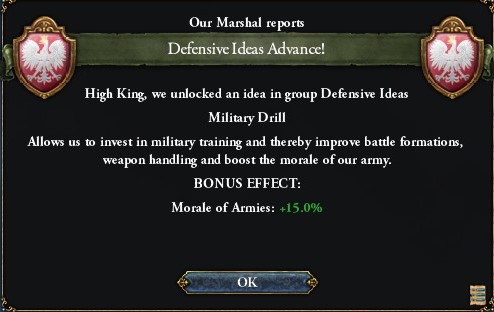
As probably should’ve been predicted, Cologne having its alliance with Italy severed makes it free game for Germany.

All in all, life in Poland and the rest of Europe quickly returns to its usual tracks, not that those tracks are always pleasant for everyone involved. High King Niezamysl II, though, doesn’t really make a return to public life. Letters exchanged within his inner circle will show historians that he isn’t really crushed or even disillusioned by the war or anything, but simply doesn’t see much purpose in addressing the Sejm when they can apparently handle their own business while he handles his.
Another potential reason for his inactivity reveals itself a year later on July 15, 1738, when the 53-year-old ruler has a sudden heart attack in his study. Servants immediately rush to his aid, but can only lay him down on the floor, and by the time the court healer arrives minutes later, he can only bark out a few sentences before passing out for the last time. After nearly thirty years on the throne, he will go down as another great and thoughtful peacetime leader, beloved by most of the populace for his devotion to their livelihoods and disinterest in sending them off to war (no matter the casus belli, any real enthusiasm for warfare is extremely marginal outside the noble elite, as most people are only trying to make ends meet and even joining the army only for the pay and free upkeep). Some historians will skim past his reign, others appreciate the sheer volume of sources he directly and indirectly left behind. Even the more discontent nobles certainly considered him better than his predecessor Stanislaw II, and in a sense it’s actually quite convenient that in his last couple years he was largely replaced in the public eye by his gregarious heir Aleksander. Now people wait to see what the war-making, treaty-signing prince will actually be like on the throne.

The High King is dead! Long live High King Aleksander I!
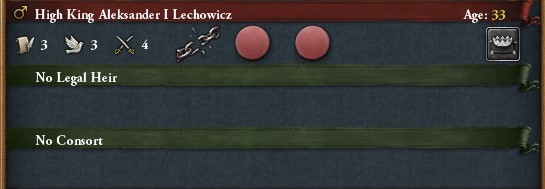
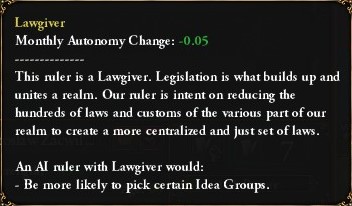
Spoiler: War & Map HighlightsThe Dalmatian War (1734-1737)
Poland + Chernigov vs. Italy + Venice + Cologne
There had been long-simmering tensions around the Polish and Italian blocs all over the world, and the only reason they hadn’t erupted into war in a long time was because both sides saw the prohibitive costs of such a global conflict as not worth it. What finally started it was the combination of a long peace, an ever-expanding military budget and opportunism on the Polish side, allowing them to quickly seize Dalmatia, Greece and various colonies. The fighting was tougher in Frisia and Cologne, where the Poles actually suffered several early defeats before breaking through due to confusion in the enemy strategy. In the end, the war was brought to a relatively swift end by the Slavs’ beeline rush for Rome, forcing Cesira Gizella I to choose between a peace and the looting of her treasured, rebuilt capital. High King Niezamysl II stayed out of the war from beginning to end, seeing it as both distasteful and unnecessary.

- The humiliating peace treaty of the Dalmatian War allowed the Italian army to survive largely intact, ensuring that at least it’ll still win its war against Asturias. There’s also some colonial skirmishing between the two, mainly around Aotearoa where Asturias has some island bases.
Spoiler: CommentsHopefully not too disappointing. I mean, obviously I started this war now because they were going to be distracted, but it still would’ve been a lot harder if the AI wasn’t (ironically) so bad at multitasking. I struggled whenever the Italian murderstack was sent against me, but then it spent the latter half of the war walking aimlessly back and forth between France and Iberia and barely even trying to fight. That’s why I need to balance “doing something” with not just steamrolling everyone, yadda yadda, how often I end up talking about this goes to show how preoccupied I’m thinking about it. But Aleksander is right that I really don’t have much interest, in or out of game, in any more of Italy’s land, so who knows if this unofficial agreement actually holds.
This is the last chapter written during the outage, so we’re back to releasing as they’re finished.Last edited by SilverLeaf167; 2020-03-22 at 12:09 PM.
-
2020-02-26, 12:31 PM (ISO 8601)Ogre in the Playground

- Join Date
- Feb 2016
- Location
- Earth and/or not-Earth
- Gender

 Re: Paradox AAR - Saga of the Slavs
Re: Paradox AAR - Saga of the Slavs
Interesting interesting. I wonder, given that Italy's army is largely intact, if they'll try to take back what they just lost once the truce is up. That seems like it would be a much more difficult conflict.
-
2020-02-26, 05:49 PM (ISO 8601)Ogre in the Playground


- Join Date
- May 2009
 Re: Paradox AAR - Saga of the Slavs
Re: Paradox AAR - Saga of the Slavs
Hmm. Yeah, a bit of an anticlimax...would've been interesting to see the French strategy, raising the Italian WE with occupation. Maybe that'd end up with the revolution triggering and getting some momentum, which would shake things up.
ithilanor on Steam.
-
2020-04-04, 09:51 AM (ISO 8601)Bugbear in the Playground


- Join Date
- Jun 2010
- Location
- Helsinki, Finland
- Gender

 Re: Paradox AAR - Saga of the Slavs
Re: Paradox AAR - Saga of the Slavs
Chapter #45: Enemies in the Spirit of Civility (Aleksander I, 1738-1745)
Spoiler: ChapterJuly 15, 1738
Aleksander I is already a distinguished figure upon his rise to the throne, having forged himself a reputation as Poland’s military and foreign policy leader and basically serving as Niezamysl II’s public representative ever since the war. Already as High Marshal he was crafting and signing treaties under his own authority, and seems to be quite legal-minded in general, seeing laws and agreements both as something to be honored and as a useful tool to use for his own ends. Of course, this end is almost always to increase the power of the Polish crown. His most famous achievement is the Treaty of Rome of 1737, supposedly dividing Europe into Slavic, Nordic and Christian spheres of power. Now it’s up to the different parties to honor it.


He for one intends to do so, considering European wars too expensive, high-mortality and dangerous to the Polish homeland in comparison to the advantages of peaceful (if sometimes grudging) trade. However, even if it’s true that the power struggle with Italy isn’t the apocalyptic holy war some present it as, the explicit acknowledgement of this fact – not to mention tying down the country with any actual treaties – proves more than a bit controversial in the Sejm. Now that he’s actually in charge rather than just making speeches, Aleksander I is off to a rough start, having to make tough choices between his personal image and national unity.

Of course, the High King is certainly no pacifist or kind soul. In fact, he’s gotten quite used to getting all the success, power and money he wants, which also leads to most of his promises having the feeling of condescending handouts from someone in a position of power rather than bilateral, equal treaties. In private, he’s leveraging that ever-increasing money and power for his own luxury.

For a long time, including under his predecessor, Poland’s economic policies have involved keeping relatively little money stockpiled and investing as much of it as possible back into the country, which most would argue has fueled massive economic growth and development everywhere from infrastructure to education. However, the attitude Aleksander I has picked up from a few select advisors is that this generous spending has made its recipients careless, the crown hasn’t demanded proportionate control over how the money is used, and combined with the growing gold and silver shipments from Nowa Straya, the amount of money in circulation has kept inflation on the rise. The lack of a stockpile has also forced the crown to actually take loans from its own subjects when struck with a sudden need for cash, not that it’s had any trouble paying them back. With all this in mind, the High King starts implementing what historians might call austerity policies, greatly reducing government investment – though some would claim that he’s just redirecting it to himself and his cronies instead. Of course, neither Poland nor really any other country has anything approaching a social security system anyway, so the direct effects of this austerity are restricted to the upper and middle classes who usually benefit from these investments.
Partly to save on expenses, partly because he’s looking to wind down hostilities anyway, and partly because they hold a lot of positions he’d rather give to other people, Aleksander I also adops a strict stance towards the meczenniks from the get-go. They are denied their customary bonuses, no members or associates are picked for his Crown Council, and he also begins unspoken but rather obvious efforts to move them to more out-of-the-way positions. Though they provide valuable and (usually) well-trained manpower for the army, he seems to be weighing his options to get rid of them or at least eliminate them as a political player.
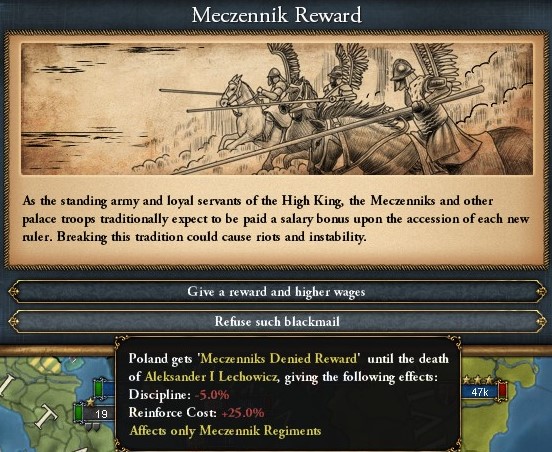
In any case, the High King’s treaties say nothing about the world outside Europe, which he’s eyeing with increased interest to sate both his unruly nobles and himself. The bloated Sultanate of Pasai is the last major native power in the East Indies not to fall under Polish influence yet, and Aleksander I is happy to change that, especially as it only really means sending orders to the troops already in the region.

The war starts in April 1739. Pasai is actually decently large, but in quite a sorry state, having gotten itself involved with Chinese politics only to now be abandoned by Wu in its time of need.

As Polish troops march into barely defended Pasai, elsewhere, the Italian-Asturian war comes to an ignoble end. The Balearic Islands and a number of colonies change hands, but while it’s clear that Italy won a crushing victory, it probably would’ve been far more crushing without Poland’s interference. Most notably, Italy carves out a chunk of southern Amatica to try and replace its loss of Fiorita, but while the lands it takes are quite valuable, they also have a sizable Andalusian population and sit right next to some of the most rebel-torn parts of Tayshas.
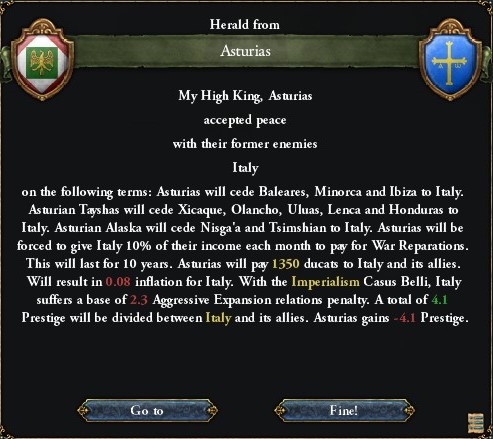

Germany also wraps up its war against the republics of Cologne and Bar, strengthening its hold over the Rhineland region.

Pasai’s ally Ligor gives up within months, and the Poles settle for heavy monetary and diplomatic penalties in order to free up more troops for the occupation of Pasai proper. Elsewhere, the same Chinese that refused to help them win their first real victory against Rajasthan, squeezing out a favorable peace deal. While some might consider the amount of land won inconsequential compared to the parts of China still under foreign occupation, it may mark an important turning of the tide.
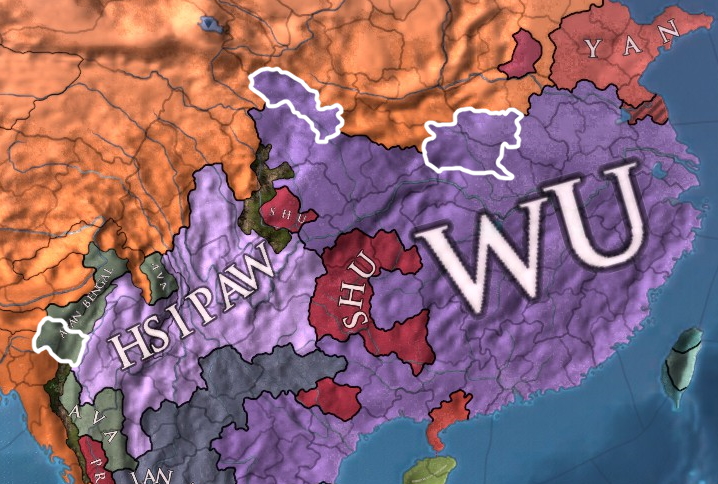
Back on the homefront, Aleksander I has to personally address another political controversy, directly related to the scientific and “rationalist” policies of his predecessor. The Khazar cities around the Black Sea have, pleasantly enough, become a minor hub of medical research, but this has also given rise to a black market for all kinds of unsavory materials, not least human corpses. Though it is in fact impoverished Jews digging up the bodies of Jews, and the local Jews themselves are obviously the ones most outraged, to the pagans (who mostly associate graverobbing with black magic even if not sacrilege in itself) this threatens to become a more widespread stereotype of the oddani. In any case, the High King decides to put an end to the whole practice, declaring harsh punishments for graverobbing or “body snatching” throughout the country and leaving the doctors to obtain their test subjects elsewhere. His relationship with the so-called scientific community and its associates starts to worsen in general.

His penchant for deal-making seems to prove more successful in Frisia, where he manages to soothe both longstanding grudges and more recent grievances (mostly over preferential treatment for Yugoslavia) with a series of new agreements regarding its political and economic autonomy, or lack thereof. Practical measures can only go so far in the face of ever-growing cultural identity, though, and the general tension remains.

His generals strike an even more one-sided deal with Pasai in July 1740, annexing the vast majority of the country into the East India Company without really having fought a single major battle. It’s a lot of land, and a lot of people, for comparatively cheap. Profit!
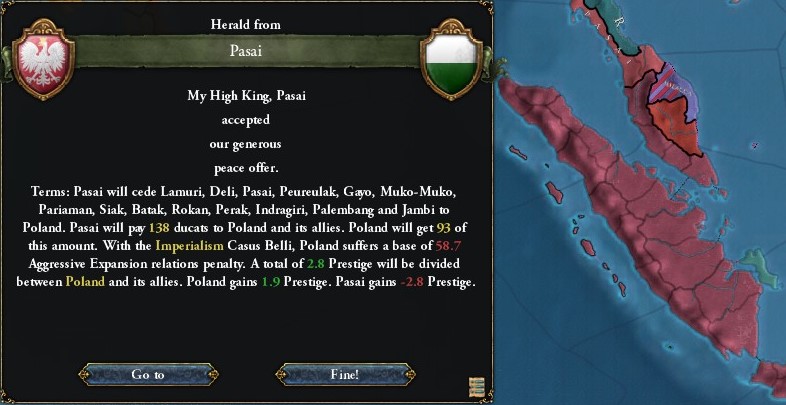
Not much later in November, Chernigov (sigh) requests Polish help in a colonial war it’s starting in southeast Africa. It’s not an entirely African affair, though, since Arabia is closely involved in the region and has already vowed to defend the republic of Betsimisaraka. Still, since Rûm isn’t participating, Poland and Moldavia seem sufficiently safe from any repercussions, and Chernigov is leveraging both its previous help in the Dalmatian War and Aleksander I’s diplomatic tendencies to make him promise his aid.
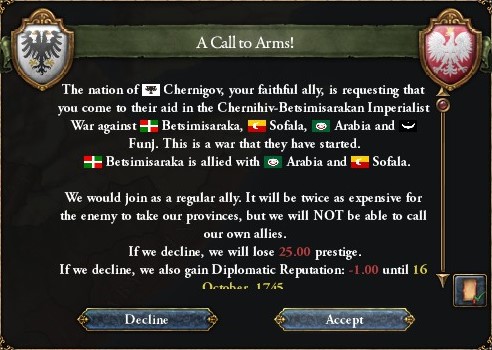
Poland doesn’t really have any troops in the neighborhood, though, and the East Indian garrisons are still needed to secure the recently annexed provinces, so it’s going to be a while before any real fighting can happen.

It’s surely not unrelated that Italy almost immediately sends an embassy to Sofala, forging a closer alliance against any (other) European incursion. Luckily, the Cesira stops short of joining this current war, but this reminds the High King that he still needs to keep most of his army in Europe and stay careful in case she does use it as a pretext for invasion.
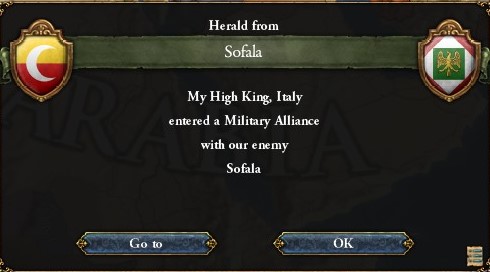
Arabia seems to opt for what could be called annoyance tactics, sending a large fleet and nearly 40,000 soldiers to harass the Polish colonies in West Africa. At least the Scottish army in the region is eager to run interference. The Grand Marynarka and Atlantic Fleet are rallied to get the coast under control, but they’ll take a long time to get there.

As the High King starts organizing this large-scale response, some gaping holes where meczennik officers used to be quickly make themselves more and more apparent…

Still, ferried over by the Black Fleet and marching through the Levant, the Slavs strike straight for Arabia. Aleksander I himself isn’t present on the field, but Arabia’s most important harbor Alexandria is seized by May 1741 after a naval skirmish and amphibious landings around the city. Cairo, Arabia’s “second capital”, follows a couple months later.

After these initial moves, the whole war seems to become a continent-sized game of cat and mouse for several years, with forces big and small chasing each other across the Egyptian desert, the Senegali savannah and even the Chernihiv steppe. It’s another war of maneuver and logistics, though, with little to no pitched battles for the Poles. At least the army is getting a lot of “valuable experience” in managing troop movements and sprawling supply trains in less hospitable environments.

As it happens, the East Indies garrisons do end up having to deal with an armed uprising of over 100,000 people in the urban centers around the Straits of Malacca in March 1742. The rebels don’t really stand a chance against the Poles on the battlefield, but due to the size of the uprising, it still takes until autumn to properly suppress. After then, the garrisons are finally able to send some troops to support the war effort.

Rebel sentiment seems to be high all over the place, with another (much smaller and little-remembered) uprising occurring in Polish Hungary, and yet another among the German minorities of Frisia. The latter in particular are actually notable as a rare breed of young, well-educated idealists who dream of escaping Polish, Frisian and monarchist oppression all at once and establishing a free republic of their own. Unfortunately, their education must be of the human sciences kind, as they apparently cannot count, happily splitting up and charging the Frisian military only to get themselves slaughtered. Anti-Polish sentiment is often accepted, or even quietly encouraged, but apparently the vassal government will tolerate no protest against its own regime.
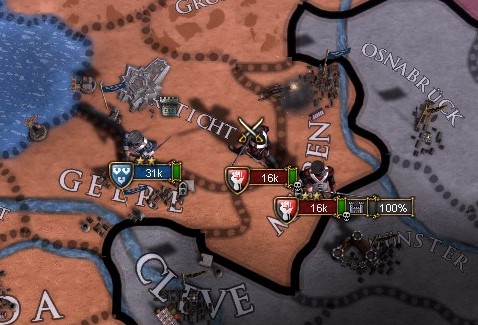
Asturian Tayshas remains an anarchic mess of political, religious and native rebels of all kinds, bankrupt several times over and with little help forthcoming from the motherland. Tayshas' attempts to use its large stores of precious metals to mint more and more money have failed to fix its economic woes and only made them worse, and now most of those mines have been seized by the rebels anyway.
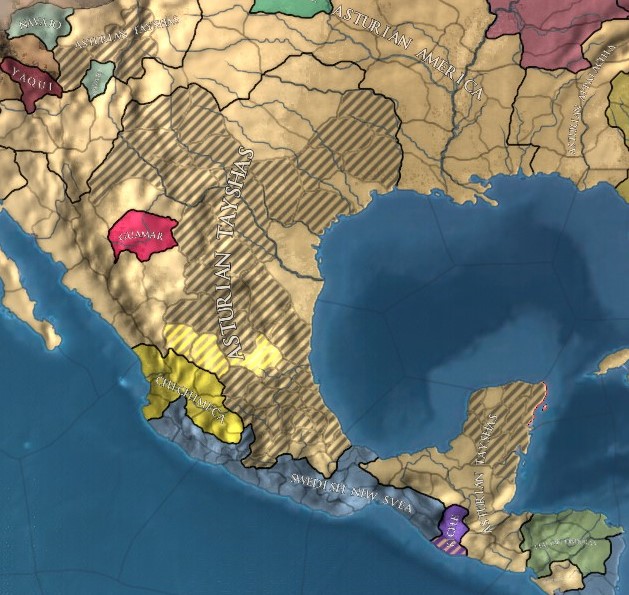
In a rare reversal of fate, Tripolitania (having unified most of the former Sardinian colonies) and Kanem Bornu unify their forces to invade the scraps of Francia and, if successful, conquer a piece of Europe proper for the first time since the Andalusian invasion of Iberia over a thousand years ago.

As for the Chernihiv-Arabian war, well, it turns out to be about as grueling as one might expect from one covering such a large area. The High King saves Polish lives, but certainly doesn’t make the war go any faster, by declaring that the armies will park themselves in the nicest part of Egypt to secure it rather than wade much deeper south, in particular the mountains of Abyssinia. Still, on another front, it is in fact the Poles who launch the first invasion of the Betsimisarakan heartland in Madagascar – nearly all the fighting has been against Arabia – in hopes of the war actually ending sometime soon.

That it does, in August 1744, but not in the manner expected: after the King of Chernigov dies of the health problems brought by old age, his young and “soft-hearted” heir apparently takes a second look at this war and decides that it’s not worth the trouble, coming to the same conclusion as his Polish counterpart that a full occupation of Arabia would be too costly. After already sinking tons of money and lives into it, he offers (the already pretty much beaten) Betsimisaraka a full withdrawal in exchange for some indemnities and admission of defeat, effectively a white peace for no good reason. When the Polish general in charge of the occupation of Madagascar is told of this, he actually arrests the messenger as an enemy infiltrator bringing false information to deceive him, but eventually learns the truth and has no choice but to leave the island.
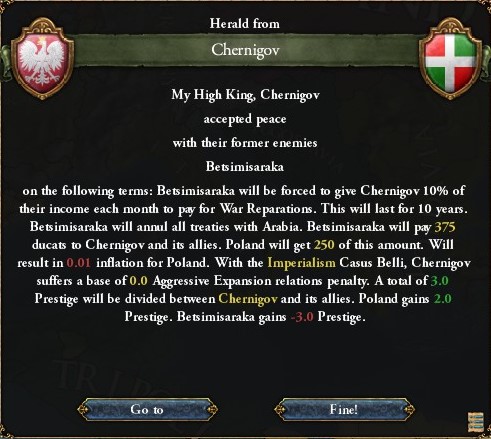
There is outrage in Krakow as well: against Chernigov, but also against Aleksander I for wasting time with this war to begin with when history has already made it clear that nothing good comes out of Chernigov’s southern wars. It’s something a more popular ruler might be able to get away with, but the goodwill he had with the nobles has been quickly depleted by his unfortunate mix of “bullheaded legalism except when it comes to himself”. Opponents say that he treats foreign rulers better than his own subjects, and their narrative goes that while his foolishness dragged them into the war, it was his indecisiveness that led to it all being in vain. Now he has his hands full trying to appease them with whatever promises he can bring himself to make (and push through the strict procedures he himself put in place).
Of course, it’s not the first time that things get heated in Krakow, but it’s also a part of the local political culture and usually doesn’t lead to anything too serious, with the destructive Confederate Civil War of 1601-1604 as a rare exception. However, that’s partly because most of the time it’s just the Sejm and not the actual military joining the debate. That may be different this time around, as the meczenniks are among the people with the most grudges against Aleksander I. Having been sidelined in the conduct of the war, its outcome, and now even the appeasements that follow, they’re on the verge of taking action.
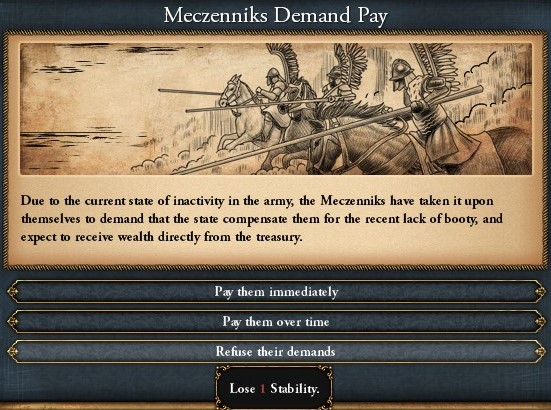
While originally just a way to extract some extra manpower from the oddani population, in the 300 years since, the meczenniks have grown into an understated but highly important presence in the military and civilian administration alike. Several rulers have turned to them when their control over the nobility seemed shaky. They’re scattered in low-to-medium ranking positions throughout the country, connected by an official network, oddani religion and their own distinct culture, all of which would be a big problem if they weren’t fanatically loyal to the crown. Usually.
Reforms to military recruitment, innocent in any other context, continue to put them on edge. At the same time that high command is further centralized, local organization is tied more closely to province lines and city registers. Notably, any mention of special forces such as the meczenniks is conspicuously absent in this new chain of command.

It all comes to a head with the so-called Černá Affair in the summer of 1745. The female (and thus volunteer) meczennik officer Maria Černá is arrested in Prague, in a largely routine manner, on charges of redirecting laborers' wages to pay her fellow soldiers instead. Such cases usually end on relatively mild fines and little more, but the High King has recently introduced harsher punishments for any kind of sedition within the military – and whether the crown knows it or not, Černá is in fact closely involved in a fledgling anti-Aleksander conspiracy that threatens to be revealed if the trial goes through. Before it even starts properly, her allies have already decided not to give the process the benefit of the doubt.

On the night of the Kupala feast on the summer solstice, when great festivals are held in every little hamlet and officials and soldiers alike are mostly away on leave, the meczenniks fill their usual roles in securing the Krakow feast where the High King is also present. He’s had enough foresight to stop using them as his bodyguards and place them under non-meczennik officers, but replacing the entire city guard is easier said than done, and they still far outnumber the loyalists on site.
As the citizens gather to watch the unsuspecting Aleksander I light a ceremonial bonfire, the meczenniks suddenly open fire on his retinue. They’re not aiming for the High King, but he also gets wounded in the side. All hell breaks loose as the rebels knock over fires and stands, overpower the shellshocked soldiers in their way and whisk the High King away into the night. Thus begins the Kupala Coup.
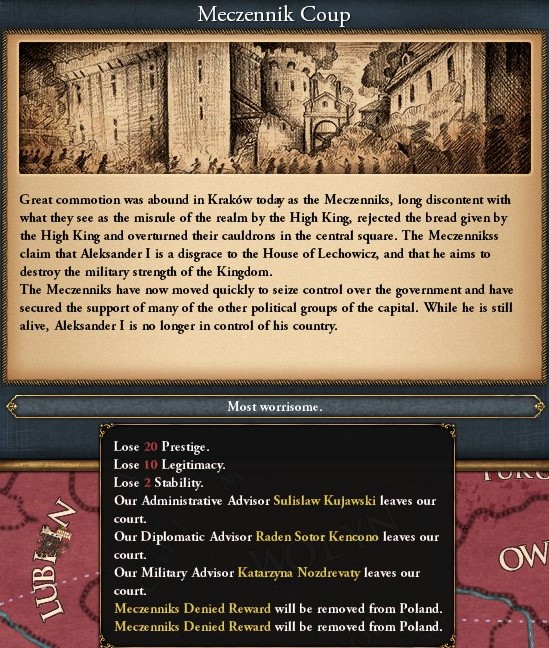
Spoiler: CommentsI’ve been a bit busy (as well as “busy” i.e. distracted), but with You Know What going on, I should start having a lot more time for this again now that I’ve gotten my other things in order. We for the record are in non-binding isolation mode, with almost all public facilities and businesses closed and gatherings banned, but no strict curfew against just going out for a walk or groceries, so really it just means having all my commitments canceled for a lot more free time to spend as unproductively as possible. Interesting times.
I found a modifier in the save file that should control the difficulty level. I moved it up one notch at first, just to make it a bit more gradual, and will switch to Very Hard from the next chapter forward for a bit more late-game challenge. The modifiers for max difficulty are actually pretty big. Combined with this coup, and me intending to “roleplay” some stuff over the course of it, I actually don’t know what the balance of power will be like. Of course, it's not the first time I've said that.Last edited by SilverLeaf167; 2020-04-04 at 04:53 PM.
-
2020-04-04, 01:14 PM (ISO 8601)Ogre in the Playground


- Join Date
- May 2009
 Re: Paradox AAR - Saga of the Slavs
Re: Paradox AAR - Saga of the Slavs
Well this should certainly shake things up! Were you deliberately provoking the Meczenniks to try and set this off?
ithilanor on Steam.
-
2020-04-04, 02:47 PM (ISO 8601)Bugbear in the Playground


- Join Date
- Jun 2010
- Location
- Helsinki, Finland
- Gender

 Re: Paradox AAR - Saga of the Slavs
Re: Paradox AAR - Saga of the Slavs
Basically, we had fulfilled the requirements since forever, but like a couple other historical events, it never fired even when it should've due to a coding hangup. (It's a reskin of the Ottomans' janissary coup, like the meczenniks as a whole are of the janissaries.) Figuring we could use the variety anyway, I kinda forced the disaster to start ticking, and then roleplayed accordingly in the lead-up to it.
-
2020-04-04, 04:41 PM (ISO 8601)Ogre in the Playground


- Join Date
- May 2009
 Re: Paradox AAR - Saga of the Slavs
Re: Paradox AAR - Saga of the Slavs
Gotcha. The RPing worked well as a setup, it felt like the kind of thing a historical ruler might've done. (If not the usual EU4 player
 )
ithilanor on Steam.
)
ithilanor on Steam.
-
2020-04-11, 08:47 AM (ISO 8601)Bugbear in the Playground


- Join Date
- Jun 2010
- Location
- Helsinki, Finland
- Gender

 Re: Paradox AAR - Saga of the Slavs
Re: Paradox AAR - Saga of the Slavs
Chapter #46: The Meczennik Menace (Aleksander II, 1745-1746)
Spoiler: Chapter25th of June, 1745
The Kupala Coup can be seen as the sum of all kinds of factors – personal unpopularity, economic policy, diplomatic failures, the replacement of external enemies with internal ones, long-term loss of faith in traditional institutions, emerging new philosophies, knowing mistreatment of the meczenniks, simply too many changes too fast – but it certainly is quick and brutally effective. People deemed too loyal to the High King are removed or worse, including his economic advisors and the Quartermaster General Katarzyna Nozdrevaty. High King Aleksander I himself becomes the world’s most valuable hostage in Pieskowa Skala castle, a cliffside fortress some ten miles from the capital, at the same time that all kinds of government offices in Krakow are basically looted or even destroyed. His 16-year-old cloaked heir, Aleksander II, is imprisoned in his quarters in Wavel Castle.
Their conspiracy itself is far from country-spanning, not even including all the meczenniks, but when they do act, many others are quick to join. Other meczenniks declare their support en masse and a disturbing number of people around Poland, some of them out of their own will and others under pressure, fail to leap to the High King’s defense. In light of this, many will see the whole coup as a mere symptom of deeper discontent. Of course, seeing as the High King is a hostage, many legitimately fear for his life as well. Slavic religious groups are obviously among the most outraged, but hold little direct power of their own. Originally just one conspirator among many, Maria Černá is freed from prison and made into a symbol of the coup, brought to Krakow to represent the “meczennik government” in front of the nobles. They don’t officially call themselves that, claiming to simply represent “the crown” as an abstract, but there’s no hiding the fact of the matter. Their actual ultimate goals are unclear, but the least they’ll try and achieve is to force through big changes to the Polish government, both for themselves and for other groups whose favor they wish to buy.
Faced with the shocking disloyalty of their peers, those still willing to fight for the High King are left marginalized and without a proper leader. They must look abroad. Alas, while Chernigov is probably sympathetic, it’s also unpopular in Poland and its young king reluctant to get involved anyway. Novgorod has a similarly new king dealing with a (much lesser) political crisis of his own. And besides, both of them are too weak and far from Krakow to take direct action if they tried. Same goes for Sweden.
In fact, the loyalists have no choice but the unthinkable: they turn to Germany, the second-greatest pagan power. Polish-German relations have been chilly for a century now, but they seem to imagine that Germany is also tired of the situation and can be charmed simply by promising a new alliance after this coup is dealt with. In a stunt that could and will be considered treasonous by others, they ask the 22-year-old King Dalimir I to provide them with men and money for a counter-coup. However, the family drama of 1634-1636 that started this whole feud threatens to repeat itself almost to the letter: the smug young monarch promises his aid, but only on the condition that he himself is named High King of Poland (and of course Moldavia, Scotland and the rest of its subject states). In one fell swoop, he would go from King of Germany and Vladimir to uncontested sovereign of the pagan world.
He can’t truly expect this offer to be accepted, and it isn’t: the negotiators walk out in disgust. But soon after, he uses this clear lapse in Polish influence as an opportunity to declare himself “Kaiser of the Germans and Slavs” in a clear imitation of the Cesira. This in itself is just a title, of course, with no practical effect – but in the worst-case scenario, it may come to signal another whole new shift in European politics.
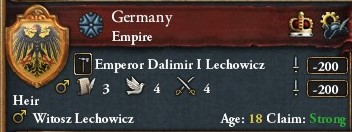
(Obviously they must’ve actually done this some time recently, but I didn’t notice until now.)
The one time that the High King, or maybe even the entire Lechowicz clan’s rule over Poland is at risk, no relative at home or abroad seems to be available to take the reins. In fact, many of them have joined the “collaborationist” nobles the same as anyone else. For the first several weeks after the coup, the prevailing mood among the majority who aren’t too enthusiastic about the situation is one of anxious confusion over how to act. Even the faint temptation of trying to claim the throne for themselves doesn't get any Lechowicz to step up.

While the meczenniks throw around promises and crown money to get people on their side, the 40-year-old Aleksander I, his gallant figure gone in an instant, paces around his comfortable but very tightly guarded quarters in Pieskowa Skala. Even his jailors seem to have mixed feelings, trying to pay him some token respect but unable to sweep under the rug the fact that they just shot him and took him prisoner. His moods change by the day, flipping from furious to depressed to almost but not quite bargaining, and he writes dozens of letters that he orders to be sent to Krakow. Only the most presentable one is actually delivered, one with a cryptic assurance to the Sejm that this will all be over soon, while the rest are hidden in the castle and only rediscovered many years later. Other than that, the High King of Poland has no contact with the outside world, and being the most powerful man in the world seems to do him no good in his gilded cage.
After a couple of weeks, things take a sudden turn for the worse as the bullet hole in his side, which already seemed to be healing just fine, shows signs of infection. While he gets some care from the best meczennik doctors they can smuggle to the castle without attracting attention, they are unable to help and his condition rapidly deteriorates. He writes many more increasingly delirious letters, none of which are sent. On 20 July, a little under a month after the coup and despite the meczenniks’ best attempts, the High King dies in isolation. To what extent he was a victim of circumstance and how much he contributed to those circumstances will be discussed for ages to come, but the fact is that the current situation was already out of his hands.
(Killed by the 33% chance in that previous event.)
The meczenniks at Pieskowa have no idea what to do. Whatever their plan really was, it definitely wasn’t to kill the High King, more to start using him as a figurehead as things stabilize. Even the rest of the conspiracy aren’t told until a week or so after the incident, when they decide that they obviously can’t just keep hiding it. They’re all in this together. There’s no turning back now.
As their spokeswoman, Maria Černá makes an announcement to the Sejm that to her immense sorrow, the High King has died of a sudden illness at his undisclosed location where he was taken good care of. Of course, the timing is far too convenient for anyone to buy, but what’s more, they have lost their royal hostage – except that Černá goes on to say that “the crown” will obviously honor the legitimate order of succession and Crown Prince Aleksander II will inherit post-haste. The meczenniks are clearly scrambling to maintain control, and the 16-year-old boy, just barely old enough to take the throne, is allowed to appear for his coronation as if nothing was wrong at all. However, there’s no doubt that he too has a dagger pressed against his back. After that, he is hardly allowed to show his face, only to press his seal upon whatever papers are handed to him.
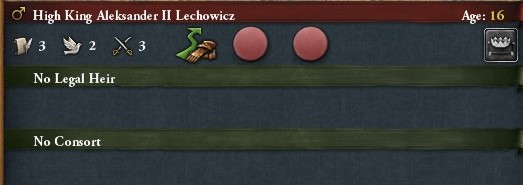
Tellingly, the governments of Moldavia and Scotland – which have been hotly debating this matter ever since the coup – both make the independent decision to not accept this meczennik puppet as their ruler. In their wording, this is just a temporary state of things, implying that they have no issue with Aleksander II per se and will talk again once proper order has been restored in Krakow. Until then, they will rule themselves (much as they have until now). While Poland’s control over them was loose to begin with, for the time being, it is officially on break. There’s concern that the more directly ruled subject states (Frisia, Yugoslavia and the voivodeships) will try to pull something similar, but for now, they remain mostly quiet on the matter if anything.


Other pagan rulers make only token approaches to the new High King and keep eyeing the situation from the sidelines, be it with caution or with hunger. Within Poland, local governments are developed and autonomous enough not to fall into total anarchy even with the political chaos in Krakow, but though the coup government’s hold over them is rather tenuous, neither side really wants to rock the boat either.
Travel times mean that it takes a while for the troops stationed in the colonies to even get a full picture of what’s happening back home, but once they do, they finally start organizing a response – not least out of concern about what will happen to the colonies if the homeland can’t protect them. The same lack of communication means that the meczennik government can’t tell what’s happening over there, either. The commanders of the Amatican and East Indies garrisons start immediately arresting all meczennik soldiers, officials and other suspected traitors (probably including some personal enemies) in their respective regions, hurrying to fill the resulting gaps in their ranks with local recruits or conscription. The meczennik presence is relatively small compared to the homeland, so they succeed without much trouble, but the latter part causes tension with local authorities.
Once they have done that, word arrives in Frisia that the colonies have been secured and that they should do the same. Finally feeling free to act, the commander of the Frisian garrison, old man Prendota Lechowicz, starts to take more of a role as the leader of the loyalist resistance. There was little love lost between him and the late Aleksander I, starting with some lingering grudges from the Dalmatian War almost twenty years ago, which is probably why he has escaped suspicion since the coup; but he remains loyal to the crown and likes the meczennik government even less. He has a lot of contacts and personal respect within the military, though now he must wield them carefully lest the plot be revealed too quickly.

Of course, there’s only so long that the resistance movement can remain hidden once it starts purging meczenniks and recruiting new troops in mainland Europe. Luckily there’s also only so much the meczenniks can do about it. Once it becomes clear that someone is able and willing to act against them, at the same time that all but the most shallow of their promises fail to manifest in practice, what little support they had vanishes almost as quickly as it came. Some of the meczennik leaders flail desperately, while others almost seem to accept their fate. It all went wrong the moment that stray bullet hit the High King, if it was ever going to work at all. Tensions run high on all levels of society and a lot of fights, riots and even small military skirmishes start popping up around the country.
In late November, after almost half a year of national paralysis, the situation is finally ripe for an army – led by Prendota’s colleague Zelibrat Lechowicz – to march through Krakow, the meczennik guards standing aside in their way, and right up to the gates of Wavel Castle. They demand the release of the young High King and the immediate surrender of the meczennik leadership. These demands are met. Some try to flee, but most are quickly caught. Aleksander II seems practically clueless to all that’s going on, but under the generals’ guidance, he makes a public appearance mere hours later to announce an urgent “inspection” of all meczennik forces, their role in this high treason and what he calls the murder of the previous High King. Those who had nothing to do with the coup have nothing to fear, he says. But as he continues talking, he clearly starts shaking off the dust of his five months of imprisonment and speaking with increased fervor – not that of the generals, but of his own – about those injustices and the retribution to come.

Only a few days into the inspection, it becomes clear that regardless of what the High King said, mere membership of the meczenniks is in fact pretty much enough to be deemed guilty of colluding against the crown and the Polish nation. There are many instances of them being chased down in the street and humiliated, beaten or killed. More royal decrees all but declare the Kolekcja system defunct, continue the dissolvement of the meczennik organization that was already begun before the coup, and soon also expand to target nobles who seemed a little too happy to collaborate. The remaining meczenniks and the nobles now in the same boat put together one last hurrah, staging a large uprising in Prague, a city with a large meczennik presence and where this whole mess originally began. They rally behind one Stanislaw Lechowicz, hoping to play on the Sejm’s fears of Aleksander II’s widespread retribution and use him as a figurehead for yet another… counter-counter-coup.

Still, at this point it’s all in vain. The rebels have little real support left, and this only provides the loyalists with the last justification they need to dismantle the meczenniks altogether (and kill a good portion of them in the fighting itself). By the start of February 1746, the meczennik rebellion seems to finally be over at last. Poland can finally begin its return to normalcy.
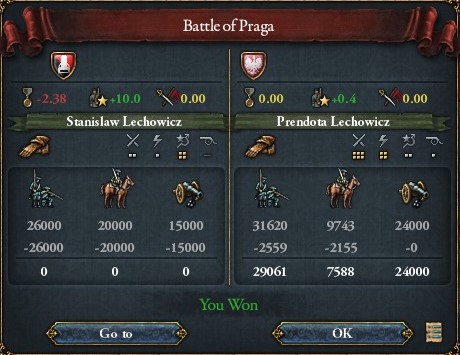
Easier said than done. The generals are in agreement that they can’t let it look like they’re just grabbing power for themselves, so Aleksander II must assume his full duties at the first opportunity. Besides all the work to be done internally, this also includes reestablishing control over Poland’s subject states. Alas: in the meantime, Moldavia’s regent government has begun an invasion of the Serbian rump state, implicitly taking back the reins of its own foreign policy. This otherwise minor war is a direct violation of the agreement between Poland and Moldavia, and the Poles tell them as much, demanding that they cease hostilities immediately out of principle if nothing else. The argument escalates, culminating in the Moldavian declaration that they retain the right to crown whoever they want and will not be accepting Aleksander II after all. Instead, they near-unanimously elect the Speaker of the Sejm, Nadbor Movilesti, as the new King of a fully independent Moldavia. Their whole acceptance of the situation hinged on a certain respect towards Poland, which has crumbled rather badly as they observed recent events. Polish power and diplomatic relations in the south seem to collapse all at once.

The Poles have higher hopes for Scotland, and negotiations do get off to a promising start, but in the end, the small regency council apparently decides that it prefers to keep its power after all. The nobles rally around a popular young man named James Abernethy, naming him King of Scotland and all its colonies. The Polish-Scottish personal union is only 30 years old and their cultural ties a lot more distant, so this process is also a lot less dramatic on both sides. However, it comes at a time when the government in Krakow is truly anxious to strengthen itself wherever it possibly can.

Seeing the mess that his diplomats have made, Aleksander II immediately begins efforts to mend broken relations and win back Moldavia and Scotland as allies even if not subjects. At the same time, the military must work double-time to make up for the loss of the meczenniks and vassal armies alike. But even as the crown government starts to regain its grip on power, the sheer amount of shocks in the last year or so has shaken many people’s worldview to its foundations. Immediately after reaching its territorial peak, the worst doomsayers proclaim that the Polish great power has come crashing down and reached the end of its golden age, paving the way for even greater upheaval to come. It is left to the people in charge to prove them wrong.
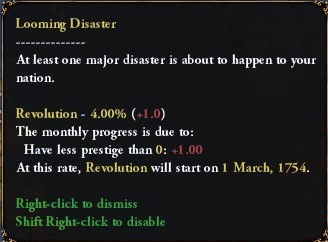
Spoiler: CommentsThe coup disaster already has a good chance of killing your monarch… and then he gets killed by a generic event that fires at times of low stability instead. At least Aleksander II didn’t then get killed by the “proper” event that usually fires…
More of a narrative chapter, but I figured that what might turn out to be some of the most important months of European history were best not skimmed over. When I do get the inspiration for one, I generally try to roll with it. Breaking the personal unions was obviously a manual self-nerf on my part, but appropriate both in-universe and on a meta level, I believe. And as for that thing at the end: we’re at -4 prestige and likely to recover it pretty quickly, so the revolution is unlikely to come to pass – unlike the meczennik coup, I’m not going to force it – but it is hopefully a thematic setup for global events to come, elsewhere if not necessarily in Poland.Last edited by SilverLeaf167; 2020-04-11 at 11:11 AM.
-
2020-04-11, 11:11 AM (ISO 8601)Ogre in the Playground

- Join Date
- Feb 2016
- Location
- Earth and/or not-Earth
- Gender

 Re: Paradox AAR - Saga of the Slavs
Re: Paradox AAR - Saga of the Slavs
That was both shorter and less disastrous than I was expecting, which is a good thing, I suppose. And it will be interesting to see how things go moving forward. Will these disruptions weaken Poland enough for a foreign enemy to actually get the better of them for once?





 Reply With Quote
Reply With Quote




 RSS Feeds:
RSS Feeds: 

